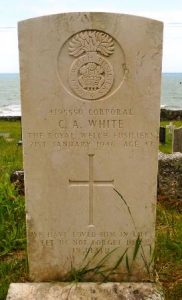Barmouth is a town situated on the north side of the estuary of the River Mawddach, in the ancient county of Merionethshire. The town grew around the shipbuilding industry, and more recently as a seaside resort, enjoying a sea view over Cardigan Bay, to its west, and a fine view of the Snowdonia mountains and Cader Idris to its east. The men of the town who fell during both World Wars are commemorated on its war memorial, which is situated within a memorial garden on Northfield Road. The memorial was erected in 1923 and extra names were added after World War Two to commemorate the men who fell in the latter war.
The Great War, 1914-1918
Evan John Allen, Ordinary Seaman, J/51049, Royal Navy. Evan was born at Newport, Shropshire on 14 June 1896, the son of Henry Herbert Allen and Gwen Allen. His mother was from Llanaber, and the family also had a home at Anchor House, Barmouth. Evan enlisted into the Royal Navy on 15 March 1916 and trained at HMS Victory I, before being posted to HMS Dido for further training. He was then posted aboard the brand-new destroyer HMS Recruit on 19 May 1917. Recruit had only been commissioned the previous month, before being assigned to the Tenth Destroyer Flotilla as part of the Harwich Force. On 9 August 1917 she was on patrol in the North Sea when she was hit by a torpedo from the German submarine UB-16 and sank some three miles off the Noord Hinder lightvessel, with the loss of 53 lives. Evan was 22 years old when he died during the sinking, and is commemorated on the Portsmouth Naval Memorial, Hampshire.
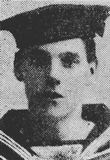
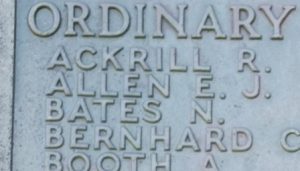
Richard William Jones Ashton, Private, 2581, Australian Infantry. Richard was born at Barmouth in 1871, the son of Charles Ashton and Janet Ashton (nee Jones). By 1891 he was living in Australia and married Lucy Marie Black before the couple set up home at 52 Bourke Street, Kalgoorlie, Western Australia. Richard enlisted at Blackboy Hill into the 6th Reinforcements for the 28th Battalion, Australian Infantry on 15 August 1915, and embarked from Fremantle, Western Australia, on board HMAT A38 Ulysses on 2 November 1915 for Egypt. On 3 March 1916 he was posted to the newly formed 51st Battalion, Australian Infantry, which had been created during the doubling of the AIF, and was part of the 13th Brigade, 4th Australian Division. The Division landed in France on 12 June 1916, and took over a section of the line at the nursery sector, near Armentières, soon after. In August the Division moved south and relieved the 2nd Australian Division at Pozieres, before taking part in the terrible fighting for Mouquet Farm. Richard was killed in action at Mouquet Farm at some time between 14 and 16 August 1916, aged 49. He has no known grave and is commemorated on the Villers-Bretonneux Memorial, France. A nephew, Private 3428 Charles James Stacey Chapple, 16th Bn AIF, was killed in action on 7 February 1917. Richard is not commemorated on the Barmouth Memorial.
John Astley, Sergeant, 18270, Welsh Regiment. John was born in 1874, the son of John and Elizabeth Astley, of Cumberland Place, Barmouth. He moved to Pentre, Rhondda to find work as a collier as a young man, and enlisted there into the Cardigan Royal Garrison Artillery (Militia), on 3 March 1898. He married Thirza Annie Fox on 16 October 1902, and the couple had a son, John, in 1906. John enlisted into the 10th Battalion, Welsh Regiment at Pentre on 4 October 1914 and joined the battalion at Rhyl. On 19 June 1915 he was transferred to the 20th Battalion, Welsh Regiment, a training battalion at Kinmel Park, due to his age, and remained in Kinmel until being posted to the 3rd (Garrison) Battalion, Royal Welsh Fusiliers on 5 April 1916. On 12 May 1917 he was posted to the 78th Company, Labour Corps at Litherland. His health had by now began to break down, and he was discharged from the army on 24 April 1918 after having been diagnosed as suffering from heart disease. By now he had separated from his wife and upon his discharge went to live at 46, Ernest Street, Rhyl. John died of heart disease at Rhyl on 25 November 1919, aged 45. He is buried in Rhyl Town Cemetery, Wales.
Herbert Berridge, Private, 41637, Lincolnshire Regiment. Herbert was the son of John and Kate Berridge of Cottesmore, Rutland. He married Margaret Morris, a domestic servant from Barmouth, at Leicester in 1909, and at some time prior to 1914 the couple moved to 3, Tai Isaf, Barmouth with their five children. Herbert enlisted into the Leicestershire Regiment at Oakham soon after the outbreak of war and after completing his training was posted to the 2nd Battalion, Lincolnshire Regiment. The battalion had been in France since 6 November 1914 attached to 25 Brigade, 8th Division. On 1 February 1918 the battalion was at Watou, training, when it received news that it was to join 62 Brigade, 21st Division. On 3 February the battalion entrained at Godewaersvelde for Péronne and marched to Haut-Allaines, where it rested before joining the 21st Division at Gurlu Wood, where the men began work improving the trenches. On 21 March 1918 the Germans launched a massive offensive along the line running from Cambrai to Péronne, and the Division got caught up in terrible fighting over the coming days at it was forced back towards Clery-sur-Somme. On 27 March the Division was relieved by the Australians and was transferred to the quieter Lys sector to recover and took up positions near Kemmel. Unfortunately, on 9 April the Germans launched the second phase of their offensive in the Lys sector, and the 21st Division again became caught up in desperate fighting. On 16 April 1918 Herbert’s battalion carried out a desperate counter-attack on the Peckham to Maedelstede Line. Herbert was killed in action during the fighting that day. He was 34 years old and is buried in Wytschaete Military Cemetery, Belgium.
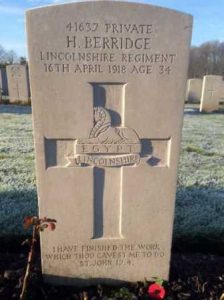
Edward Arthur Blacker, Private, 37786, West Yorkshire Regiment. Edward was born in Mapplewell, Yorkshire in 1897, the son of Arthur and Ann Blacker. By 1901 the family was living at Victoria Buildings, Barmouth, where Arthur’s father worked as a gardener. Prior to the war his father had taken up work as a coal miner and had moved the family to 37, Garnet Terrace, Dewsbury Road, Leeds. Edward enlisted at York into the army and was posted to the 17th Battalion, West Yorkshire Regiment. The battalion had landed in France on 1 February 1916 attached to 106 Brigade, 35th Division and saw its first major action during the Battle of the Somme. By December 1916, the Division had to be re-organised, as it was deemed to be suffering from low physical and morale standards, and did not go back into action until March 1917 when the Division followed the German Retreat to the Hindenburg Line. Later in the year it moved north to Ypres, and fought at the Second Battle of Passchendaele. On 16 November Edward’s battalion left the 35th Division to carry out railway work for XIX Corps, and three weeks later amalgamated with the 15th Battalion at Acq to form the 15th/17th Battalion, West Yorkshire Regiment. The new battalion had a relatively quiet winter, but on 22 March 1918 moved to the Bullecourt Sector to reinforce the line following the launch of the German offensive the previous day and saw heavy fighting during the withdrawal over the coming days. On 27 March 1918 the battalion became completely encircled by the Germans at Moyenvilles, and suffered the loss of over 600 men during the day. Edward was taken prisoner by the Germans during the day and was taken to a POW Camp at Antwerp. Sadly, he became ill and died of dysentery there on 5 November 1918, aged 21, less than a week before the Armistice. He is buried in Schoonselhof Cemetery, Belgium.
Edmund Maurice Buckley, Second Lieutenant, Royal Welsh Fusiliers. Edmund was born on 1 December 1886, the only son of Sir Edmund Buckley, Second Baronet Mawddy, and Lady Harriet Olivia Louise Buckley (nee Lloyd), of Aberhirnant Hall, Bala; Plas Dinas, Dinas Mawddwy; Milford Hall, Newtown; Grotton Hall, Saddleworth; and of Maesllan, Barmouth. He was educated at Cheltenham College before entering Manchester University in 1904 to study engineering. Upon graduating, he begun working for Humber Works Limited at Beeston, and Coventry and was placed in charge of the Motor Cycle Repair Department. He played rugby for Coventry and was the Captain of the second XV. Edmund enlisted into the Public Schools Battalion, London Regiment as a Private at the outbreak of war, and on 21 September 1914 was commissioned into the 7th Battalion, Royal Welsh Fusiliers. The battalion was a Territorial unit, which mobilised for war at Newtown in August 1914, as part of North Wales Brigade, Welsh Division and moved to Conway until the end of the month, before moving to Northampton. In December the Division moved to Cambridge and then in May 1915 to Bedford, where the Division was numbered and the formation became 158 Brigade, 53rd (Welsh) Division. On 19 July 1915 the entire Division sailed from Devonport for Imbros and on 9 August 1915 landed at Suvla Bay. The infantry moved off the beaches into the bush, but due to a lack of maps and no knowledge of the terrain, many of the units became disorientated, and the situation became chaotic. On the morning of 10 August the Division took part in an advance on Scimitar Hill under heavy fire and suffered terrible casualties, before being forced to withdraw. Edmund was wounded during the fighting, and died of his wounds on 12 August 1915, aged 29. He is buried in Lancashire Landing Cemetery, Gallipoli. Upon the death of his father in 1919, the title of Baronet Mawddy also died. Edmund is also commemorated on at least two other war memorials, at Newtown and at Dinas Mawddy.
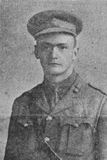
David Davies, Private, 2163, Welsh Regiment. David was originally from Dolgellau, the son of David and Mary Davies. The family later lived at Glandwr Lodge, Barmouth. David served with the 5th Battalion, Welsh Regiment, which was attached to 159 Brigade, 53rd (Welsh) Division. Little is known of David, but he doesn’t appear to have served at Gallipoli with the battalion, instead remained on home defence at Pembroke Dock. He died of disease at Pembroke Dock on 21 March 1916, aged 48 and was buried with full military honours in Pembroke Dock Military Cemetery.
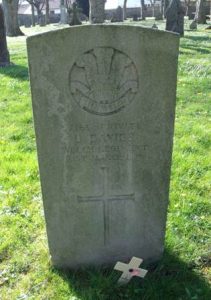
David Oswald Davies, Captain, Royal Welsh Fusiliers. David was born at Llanfyllin in 1865, the son of David Milton Davies and Mary Davies (nee Evans). His father had died in 1869, and David moved with his mother and brother Albert to live with their Uncle Evan Evans at Dovey View, Machynlleth. After obtaining his BA at Bangor University, David became a Master at Llangollen Grammar School. He had played international football for Wales in his youth. He later qualified as a Solicitor and moved to Barmouth where he established a thriving business, becoming very well known in the town. David served with the V.T.C. at Barmouth, and following the outbreak of war was commissioned into the 7th Battalion, Royal Welsh Fusiliers, and was posted to Newtown and then to Park Hall, Oswestry, where he helped train new recruits. David took ill early in 1917 and died of disease at Barmouth on 22 May 1917, aged 51. He is buried in St. Mary’s Churchyard, Llanaber.
Hugh Davies, Merchant Navy. Hugh cannot presently be identified, but the memorial states that he lived at Cambrian Street.
Thomas Davies, Private, 37132, Royal Welsh Fusiliers. Thomas was the son of John and Ellen Davies of Penlan House, Barmouth. He worked as a Grocers Assistant prior to enlisting at Barmouth into the 20th Battalion, Royal Welsh Fusiliers on 29 November 1915. After completing his training, Thomas embarked at Folkestone on 29 March 1916 and upon disembarking was posted to the 38th Infantry Base Depot at Étaples. On 10 April 1916 he was posted to the 14th Battalion, Royal Welsh Fusiliers, which was near Cuinchy attached to 113 Brigade, 38th (Welsh) Division. He was wounded on 6 May when the battalions trenches were shelled heavily and was evacuated via the 130th Field Ambulance to the 7th Casualty Clearing Station, then to the 2nd Canadian General Hospital. Thomas was evacuated by Hospital Ship back to England on 16 May, and it was almost a year before he was back in France, embarking on 3 March 1917. He spent over two months at the 5th Infantry Base Depot before being posted to the 9th Battalion, Royal Welsh Fusiliers on 25 May 1917. The battalion was by then in the Messines sector, attached to 58 Brigade, 19th (Western) Division, and was preparing to take part in the Battle of Messines Ridge. The battle was launched on 7 June 1917 following the detonation of 19 huge underground mines, which devastated the German defences, and was followed by an assault led by tanks. The 19th Division saw heavy fighting during the day, but the initial successes were not fully exploited by the British. Thomas survived the initial battle, but was killed by artillery fire while the 9th RWF was holding the line on 15 June 1917. The remains of the 24-year-old was carried back behind the line by his comrades and buried in Croonaert Chapel Cemetery, Belgium.
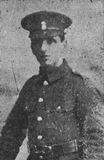
Harry Dudley, Lance Corporal, 23191, Royal Welsh Fusiliers. Harry was the son of Edward and Margaret Dudley of Coesfan, Barmouth. He worked as a gardener prior to enlisting at Barmouth into the 10th Battalion, Royal Welsh Fusiliers. The battalion was formed at Wrexham in September 1914, before joining 76 Brigade, 25th Division at Codford St. Mary, Salisbury Plain. On 27 September 1915 Harry landed at Boulogne with the battalion, which moved to Merris with the Division. On 7 October 1915 the 10th RWF took up positions in the line at Ploegsteert Wood, but two days later marched to Bailleul to join 76 Brigade, 3rd Division. The Division was holding the southern part of the Ypres Salient, and the 10th RWF had the honour of being inspected by King George V and the Belgian King Albert I on 27 October, before spending its first winter in the trenches. Harry saw his first major action during the Actions of the Bluff the following March, when the British fought desperately for control of a spoil heap on the Ypres-Comines Railway which afforded a view over the battlefield. Towards the end of March more heavy fighting broke out here, known as the Actions of the St. Eloi Craters. At 12.30 on 30 April 1916 the 3rd Division was in the line at Kemmel when the men heard the hissing of gas cylinders being opened. The cloud drifted over the British lines, and was followed by machine-gun fire. Harry was among a large number of men who suffered gas poisoning during the attack, and he died later that same day, 30 April 1916, aged 21. He is buried in Lindenhoek Chalet Military Cemetery, Belgium. One of his brothers, George, was taken POW by the Germans on 21 March 1918, while a second brother, Edward, was wounded in Mesopotamia in 1917.
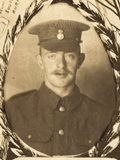
Griffith Owen Edwards, Private, 36863, Royal Welsh Fusiliers. Griffith was the son of Owen and Ann Edwards of Moss Bank, Barmouth. He worked as a shop assistant in London prior to the war and frequently visited his grandparents at Kohinoor, Barmouth. Just prior to the war Griffith took up a position in Liverpool, and he enlisted there into the Royal Welsh Fusiliers in the spring of 1915. He was posted to France in March 1916 and joined the 2nd Battalion, Royal Welsh Fusiliers, which was at Cuinchy attached to 19 Brigade, 33rd Division. The 2nd RWF had been in the Cuinchy trenches for several weeks by then, and on 7 April moved into a new location in the Auchy Left Sector to begin another tour, before going into reserve, then taking up the Cuinchy Right sub sector. This rotation continued in the same vein over the coming weeks, five to six days in the line, five to six days in billets and on 16 May the 2nd RWF moved back into the line in the Auchy Left Sector. Griffith, along with another man, Edward Edwards, of Llanfyllin, were killed in action by a shell during the battalions second day there, on 17 May 1916. Griffith was 25 years old. The remains of both men were carried back behind the line in tarpaulins by their comrades and buried together in Cambrin Churchyard Extension, France.

John Rees Edwards, Lance Corporal, G/2913, Middlesex Regiment. John was the son of Griffith Edwards and Sarah Ann (Laura) Edwards of Morben Villa, Barmouth. Prior to the war he worked for his Uncle, Evan Rees, as a dairy assistant, and lived with him at 8, Fergus Road, Highbury. He enlisted at Holborn into the Middlesex Regiment on 2 September 1914, and was posted to the 12th Battalion, Middlesex Regiment at Colchester, where it was attached to 54 Brigade, 18th (Eastern) Division. John landed at Le Havre with the battalion on 26 July 1915, and the entire 18th Division assembled and moved to the southern Somme area, near Morlancourt, where it remained over the winter. The division didn’t see its first major action until July 1916 when it took part in the Battle of Albert. It then fought at the Battle of Bazentin, where it captured Trones Wood, and then took part in the Battle of Delville Wood. On 6 August 1916 John was transferred to the 17th Battalion, Middlesex Regiment, which was also on the Somme, attached to 6 Brigade, 2nd Division. The Division was also fighting around Delville Wood and later that year took part in fighting on the Ancre. In March 1917 the Division followed the German Retreat to the Hindenburg Line, and in April fought at Arras, during the First Battle of the Scarpe. John was posted as missing here on 28 April 1917, and was afterwards deemed to have been killed in action that day. The 25-year-old has no known grave and is commemorated on the Arras Memorial, France.
Evan Llewellyn Evans, Pioneer, 130580, Royal Engineers. Evan was the son of Robert Pugh Evans and Catherine Evans (nee Pughe), of Bridge Cottage, Barmouth. He enlisted into the Royal Welsh Fusiliers soon after the outbreak of war, but was transferred to the Royal Engineers. He was posted to France early in 1916 with the 4th Battalion, Special Brigade, Royal Engineers. The unit was a chemical warfare unit, formed to handle the discharge of poison gas from cylinders. Evan had taken part in two such engagements during his short time in France. On 10 July 1916 Evan’s battalion was in billets near Doullens. He was in his bunk, cleaning his pistol, when it accidentally discharged and a bullet struck him in the head, killing him instantly. The 21-year-old was buried in Doullens Communal Cemetery Extension No. 1, France.
John Richard Evans, Private, 11998, Royal Welsh Fusiliers. John was the son of Allen and Gwen Evans, of 2, Moss Bank, Barmouth. He lived at Bangor prior to the war and enlisted at Tywyn into the 8th Battalion, Royal Welsh Fusiliers. The battalion became attached to 40 Brigade, 13th (Western) Division at Salisbury Plain and in July 1915 embarked for the Mediterranean, and arrived in Mudros before being landed on the shores of Anzac Cove, Gallipoli from 16 July 1915. John survived the ferocious fighting which followed, but at some time was invalided back to Britain, and after recovering was posted to Ypres to join the 15th Battalion, Royal Welsh Fusiliers, which was holding the Canal Bank north of the city, attached to 113 Brigade, 38th (Welsh) Division. The Division had moved here following its assault on Mametz Wood in July 1916, and held this sector until launching its offensive against the Pilckem Ridge on 31 July 1917, the opening day of the Third Battle of Ypres. Severe fighting continued here for several days, and by 4 August John had been reposted as missing. He is officially recorded as being killed in action between 31 July and 4 August 1917. The 36-year-old has no known grave and is commemorated on the Ypres (Menin Gate) Memorial, Belgium.
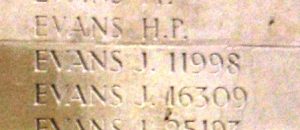
Joseph Lloyd Evans, Private, 37306, Royal Welsh Fusiliers. Joseph was the son of Griffith and Ellen Evans, of 4 Belgrave Road, Fairbourne. He worked as a milkman in London prior to the war. Joseph enlisted into the Royal Welsh Fusiliers in London on 6 December 1915 and was posted to Litherland Camp for training. On 26 April 1916 Joseph embarked at Southampton aboard the SS Copenhagen and landed in Rouen two days later, joining the Infantry Base Depot. He was posted to the 2nd Battalion, Royal Welsh Fusiliers on 7 May 1916 and on 23 June 1916 was slightly wounded by shrapnel whilst the battalion was in the front line at Givenchy. He was back on duty two days later and moved to the Somme with the battalion doon afterwards. The battalion was at the time attached to the 33rd Division, and the Division fought at the Battle of Bazentin Ridge before making an assault on High Wood. Joseph was wounded again at High Wood on 20 July, and was treated at the 4th General Hospital, Rouen, before returning to action on 4 August 1916, joining the 9th Battalion, Royal Welsh Fusiliers, which was attached to 58 Brigade, 19th (Western) Division. The Division was at Pont Remy, resting following its efforts during the earlier stages of the Somme offensive, but on 5 October entrained for Doullens, moving back to the Somme. On 26 October 1916 the Division took over Regina Trench and Hessian Trench, beginning another tour of duty. The 9th Battalion, RWF was in the line on 21 November 1916 when Joseph was killed in action. The 29-year-old has no known grave and is commemorated on the Thiepval Memorial, France. He is also commemorated on memorials at Arthog and at Llwyngwril.
Thomas George Foulkes, Private, 27226, King’s Shropshire Light Infantry. Thomas was the son of Robert William Foulkes and Catherine Foulkes, of 5, Marine Parade, Barmouth. He worked for the Cambrian Railways at Barmouth Station prior to the war. He enlisted at Dolgellau into the Training Reserve in March 1915 and at some time in 1916 was posted to the 7th Battalion, King’s Shropshire Light Infantry, which was attached to 76 Brigade, 3rd Division. The Division saw heavy fighting on the Somme that summer, especially during the Battle of Bazentin, where it captured Longueval and at the Battle of Delville Wood. It also fought in the Battle of the Ancre, before settling into another bleak winter in France. In May 1917 the Division was at Arras, and fought throughout the Battle of Arras, capturing the staunchly defended village of Roeux. During the summer the Division moved back to Ypres, and took part in the Battle of the Menin Road and the Battle of Polygon Wood. In November the Division moved south again, and took part in the Battle of Cambrai. It wintered in the area and on 21 March 1918 became caught up in the heavy fighting which followed the launching of the German Spring Offensive, which was launched on a wide front from Cambrai to St. Quentin. The 7th KSLI was in reserve near Heninel and was ordered to move forward and attempt to hold the German attacks. Thomas was killed during heavy fighting west of the ruined village of Henin on 26 March 1918, aged 19. He is buried in Wailly Orchard Cemetery, France.
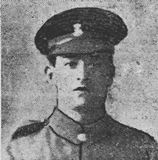
Leysters Llewellyn Greener, MC, Captain, Royal Warwickshire Regiment. Leysters was born at Aston, Warwickshire in 1893, the son of Charles Edward Greener and Harriet Hutton Greener (nee Lort). He was the grandson of William Wellington Greener, of Plas Llwyd, Barmouth. Leysters was educated at Rugby, where he was captain of the Rugby XV and the Shooting Eight, and had been commissioned into the 5th Battalion, Royal Warwickshire Regiment (Territorial Army) some 18 months before the outbreak of war. He embarked for France with the 1/6th Battalion, Royal Warwickshire Regiment on 22 March 1915. His grandfather had been a renowned gunmaker in Birmingham, and Leysters went to war armed with a converted Ross sniping rifle, becoming a renowned sniper, gaining a reported 54 kills. Leysters gained the award of the Military Cross for his gallantry the following year, for carrying out: ‘particularly efficient work under exacting conditions. His company was located on a part of the front fighting line where the Allies front turned at an acute angle and the enemies’ front line approached them at a curve which caved into the Allies front. Each side was trying to spring a mine on the other, and, as luck would have it, the enemies mine was sprung first. It created a huge crater and Lieutenant Greener, with a sergeant and two or three men, was sent over the parapet and across no man’s land to try and hold the crater until his company could dig a communication trench and send out further supplies of men and munitions. He succeeded in his task not by a brilliant dare-devil dash, but by cool carefully calculated measures – measures that at once marked him out as a capable officer. He held onto the far side of the crater, which was within about 60 yards of the enemy, in the face of hot machine gun and rifle fire. It was a very gallant action, and as efficiently organised as it was brave.’ He was wounded during grenade practice soon afterwards, losing the sight of one eye, and was not passed fit again until September 1916, when he was promoted to Captain and posted to the 2/6th Battalion, Royal Warwickshire Regiment, which was attached to 182 Brigade, 61st (South Midland) Division. The Division followed the German withdrawal to the Hindenburg Line the following year before being moved to Ypres, to take part in the Passchendaele offensive. The Division then moved to the Cambrai sector to take part in the Battle of Cambrai later that year, and took part in the terrible fighting which followed the German counter-attack from 30 November. By the beginning of December Leysters battalion was in the line near La Vacquerie and on 5 December 1917 came under heavy attack by the Germans. Leysters was killed in action leading his platoon that day. The 24-year-old has no known grave and is commemorated on the Cambrai Memorial, Louverval, France.
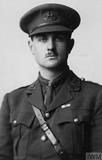
Wright Greenwood, Private, 39915, Lancashire Fusiliers. Wright was born in Ashton, Lancashire on 23 February 1889, the son of Eli Greenwood and Winifred Greenwood (nee Roberts). By 1891 the family was living in Bala, then moved back to Ashton. Wright was a regular visitor to his mother’s family at Bridgefield House, Barmouth. He enlisted into the Lancashire Fusiliers following the outbreak of war and was posted to the 10th Battalion, Lancashire Fusiliers, which was attached to 52 Brigade, 17th (Northern) Division. He probably joined the battalion on the Somme in 1916, following the Divisions move from The Bluff position near Ypres, and would then have taken part in the Battle of the Somme. During the spring of 1917 the Division took part in the Battle of Arras, before moving back to Ypres, and taking part in the First and Second Battles of Passchendaele. In March 1918 the Division was on the Somme, and faced the German Spring Offensive which was launched there on 21 March 1918. The Division was in the front line at Havrincourt when the Germans launched their attack, and came under heavy fire before being forced to withdraw over the coming days and by the morning of 25 March 1918 was near Courcelette, where it was relieved by the 63rd (Royal Naval) Division. Wright was killed that day, just prior to the relief. The 28-year-old has no known grave and is commemorated on the Arras Memorial, France.
Ellis Griffiths, Private, 39912, Royal Welsh Fusiliers. Ellis was the son of Thomas and Ellen Griffiths of Bennar Terrace, Barmouth. He worked in Liverpool Docks prior to the war and enlisted there into the Royal Welsh Fusiliers on 7 December 1915. Ellis was posted from Kinmel Park to the 10th Battalion, Royal Welsh Fusiliers on 4 April 1916, joining the battalion in France where it was attached to 76 Brigade, 3rd Division. He probably joined the battalion at Ypres, where it had seen heavy fighting during the Actions of the Bluff, and at the St Eloi Craters. The Division was then moved south to the Somme, and fought there at the Battle of Albert, and the Battle of Bazentin, where it captured Longueval. The Division then took part in the Battle of Delville Wood, where the 10th RWF gained the award of two Victoria Crosses. The Division had a short spell in the trenches at Mazingarbe until returning to the Somme sector in October and trained in readiness for another attack. On 12 November the 10th RWF took over a section of trench in front of Serre, in readiness to take part in a large-scale offensive along the Ancre valley the following morning. At 05.45 on 13 November 1916 the 10th RWF rose up from their trenches in eight lines and attacked the German lines defending Serre. Ellis was killed in action that day, a day which saw 300 casualties suffered by the battalion. He was 29 years old and is buried in Queens Cemetery, Puisieux, France.
Robert Ellis Griffiths, Leading Seaman, 2771A, Royal Naval Reserve. Robert was born at Barmouth on 27 May 1890, the son of Captain Griffith Griffiths and Dorothy Griffiths. By 1901 the family had moved to 15, Gondover Avenue, Aintree, Liverpool. Robert enlisted into the Royal Naval Reserve at Liverpool on 5 November 1910, and trained at Devonport. Over the coming years he spent time on several ships, and had travelled afar, to such places at New Orleans, Mexico, the West Indies and Canada. Robert was posted to Howe Battalion following the outbreak of war, and was with the Royal Naval Brigade at the fall of Antwerp. He was discharged at Devonport and went back to sea, serving aboard the requisitioned White Star Liner HMS Laurentic. On 23 January 1917, Laurentic left Liverpool en-route to Halifax, Nova Scotia, carrying some 479 passengers, mostly naval officers, ratings, and Naval Volunteer Reserves, as well as a cargo of gold. On 25 January 1917 she was steaming off Ireland when she struck two mines which had been laid by the German submarine U-80 off Lough Swilly, which caused her to list and sink within an hour. Robert was among 354 people who drowned in the sinking. The 26-year-old is commemorated on the Plymouth Naval Memorial, Devon.
Wynn Griffith, Officer’s Steward 2nd Class, L/8996, Royal Navy. Wynn was born on 23 April 1886, the son of William and Ellen Griffith, of The Gables, Barmouth. By 1911 he was serving in the Mercantile Marine aboard the SS Carmania as a Ships Steward and was living at 54, Berkley Street, Liverpool. Wynn originally enlisted into the Royal Naval Volunteer Reserve, and on 7 July 1916 enlisted into the Royal Navy. He trained at HMS Vivid I before being posted aboard the M-Class destroyer HMS Marne on 23 January 1917. HMS Marne was based in Belfast in October 1918 when Wynn took ill. He was admitted into the Mater Hospital at Belfast where he died on 20 October 1918, aged 33. Wynn was buried in the Glenalina Extension of Belfast City Cemetery, Ireland.
Arthur Wilson Hughes, Sapper, 154018, Canadian Pioneers. Arthur was born at Barmouth on 21 December 1879, the son of David and Eliza Hughes, of Glanydon. He was a qualified surveyor and had emigrated to Canada prior to 1911 with his brother George. Arthur enlisted at British Columbia into the Canadian Expeditionary Force on 14 August 1915 and was posted to England, joining the 1st Canadian Pioneers at Moose Barracks, Shorncliffe. He was posted to France with the battalion on 8 March 1916 and the battalion joined the 1st Canadian Division at Ypres. Arthur served on the Western Front for the rest of the war, seeing action on the Somme, at Passchendaele and also during the great 100 days offensive which won the war. After the Armistice he was posted to Kinmel Park, along with thousands of other Canadian servicemen, to await repatriation to Canada and on 15 February 1919 embarked aboard HMT Canada for Canada. On 24 March 1919 Arthur was demobilised, but sadly his ordeals in France must have been traumatic, as he was found hanging on 15 November 1919. He was 39 years old. Nothing more is known of him, as he is not commemorated by the CWGC.
David William Humphreys, Able Seaman, J/15968, Royal Navy. David was born at Barmouth on 10 March 1896, the son of William and Elizabeth Jane Humphreys. By 1911 the family was living at Oswestry, where David and his father worked for the Cambrian Railways, and then prior to the war the family had moved to Station House, Harlech. David had enlisted into the Royal Navy on 10 March 1912, signing up for 12 years. His first posting was aboard HMS Impregnable, as a Boy Sailor, and he then served aboard HMS Duncan before gaining a posting aboard the Town-class cruiser, HMS Southampton, where he was promoted to Able Seaman. Southampton had been built by John Brown & Company and was launched on 16 May 1912, before joining the 1st Battle Squadron and she became flagship of the 1st Light Cruiser Squadron in July 1913. She took part in the Battle of Heligoland Bight, and later in the Battle of Dogger Bank in early 1915. Southampton was part of Admiral John Jellicoe’s force which attacked the German High Seas Fleet at the Battle of Jutland on 31 May 1916, acting as flagship of 2nd Light Cruiser Squadron. Southampton torpedoed and sank the German light cruiser SMS Frauenlob, but sustained damage herself in the battle. David was killed in action during the battle that day. The 20-year-old was buried at sea and is commemorated on the Portsmouth Naval Memorial, Hampshire. He is also commemorated at Harlech.
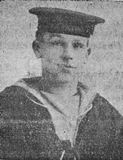
John Herbert Ingram, Private, 12906, The King’s (Liverpool Regiment). John was the son of Edwin and Margaret Ingram, of Orielton Hall Gardens, Barmouth. He enlisted at Liverpool into the 11th Battalion, King’s (Liverpool Regiment). The battalion formed at Seaforth in August 1914, becoming the Pioneer Battalion to the 14th (Light) Division, and landed in Boulogne on 30 May 1915. The Division moved to the Ypres sector and saw its first action during the Action of Hooge, where the Division was the first to be attacked by German flamethrowers. The Division then fought at the Second attack on Bellewaarde. In July 1916 it moved to the Somme, and fought at the Battles of Delville Wood, and Flers-Courcelette, and in March 1917 followed the German Retreat to the Hindenburg Line. May saw the Division take part in the Battle of Arras, before being transferred to Ypres, where it joined the great offensive, taking part in the Battle of Langemarck, and the battles of Passchendaele. In the Spring of 1918 the Division was at Clastres, near St. Quentin, and was hit by the German Spring Offensive, which was launched on 21 March. The Division fought a desperate rearguard action over the coming days, suffering over 6,000 troops. By 3 April the 11th King’s had reached Aubigny, in the Somme valley, and on 4 April 1918 came under attack again. John was killed in action near Aubigny on 5 April 1918, aged 27. He has no known grave and is commemorated on the Pozieres Memorial, France.
Arthur Meredith Jones, Private, Australian Militia. Arthur was born in Barmouth in 1895, the son of Thomas and Mary Stevenson Jones, of Celynin View. His parents died when he was young, and so Arthur and his two brothers were raised by their sister, before Arthur and his brother David emigrated to Ballarat, Australia in 1912 to live with their uncle Griffith Griffiths. The boys gained work with E. Rowlands Ltd., Mineral Water Manufacturers. Arthur enlisted into the 71st Regiment (City of Ballarat), Australian Militia at the outbreak of war. He was undergoing basic training when he became ill and died of pneumonia on 12 September 1914, aged 19. He was buried in Ballarat New Cemetery, Australia. His brother David was killed in 1917.
David Jones, Private, 4527, Australian Infantry. David was born at Barmouth in 1897, the son of Thomas and Mary Stevenson Jones, of Celynin View. His parents died when he was young, and so David and his two brothers were raised by their sister, before David and his brother Arthur emigrated to Ballarat, Australia in 1912 to live with their uncle Griffith Griffiths. The boys gained work with E. Rowlands Ltd., Mineral Water Manufacturers. David enlisted at Ballarat with his brother Arthur into the 71st Regiment (City of Ballarat), Australian Militia at the outbreak of war. On 9 July 1915 David enlisted into the 14th Reinforcements for the 8th Battalion, Australian Infantry. He embarked for Egypt aboard HMAT Themistocles and disembarked in Suez on 28 February 1916. The AIF was doubled in size in February 1916 due to a surplus of enlistees, and David was posted to the newly formed 58th Battalion, Australian Infantry, which was part of the 15th Brigade, 5th Australian Division. The Division landed in France on 23 June 1916, and moved to the Nursery Sector near Fromelles for trench initiation. It was thrown into battle on 19 July, during a diversionary attack at Fromelles, which proved disastrous, and suffered terrible casualties. Early in 1917 the Division followed the German retreat to the Hindenburg Line, and on 26 March David was shot in the arm. While recovering he paid a visit back to Barmouth to see his family, before returning to France on 30 July 1917. He re-joined the 58th Battalion in time to take part in the Divisions assault on Polygon Wood, during the Third Battle of Ypres. David was killed at Polygon Wood on 27 September 1917, aged 20. He was originally buried in a trench in Polygon Wood, but his grave was exhumed after the war and he was re-buried in Tyne Cot Cemetery, Belgium. His brother Arthur died in 1914.
Edwin Tudor Jones, Captain, Royal Welsh Fusiliers. Edwin was born in Debroghur, Bengal on 12 November 1868, the son of General Griffith Turner Jones and Elizabeth Jane Jones (nee Moran). He was originally commissioned into the 4th Battalion, Royal Welsh Fusiliers (Militia) in 1888. Edwin had served during the Boer War with the South African Constabulary and following the war returned to his ancestral home of Wales, and lived at King’s Crescent, Barmouth. He was commissioned into the 3rd Battalion, Royal Welsh Fusiliers on 5 April 1909, and by the outbreak of war was serving with the 2nd Battalion, Royal Welsh Fusiliers. The battalion landed at Rouen on 11 August 1914, joining 19 Brigade, and took part in the epic retreat from Mons to the Marne, before the BEF moved to Ypres. He was wounded at La Cordonnerie on 24 October 1914 and returned home to recover, marrying Harriet Evan Kirkby, of Tywyn, on 3 March 1915. When he recovered from his wounds, Edwin returned to France and joined the 1st Battalion, Royal Welsh Fusiliers, which was attached to 22 Brigade, 7th Division. He took part in the Battle of Loos in September 1915, and in the summer of 1915 moved south with the division to the Somme. Edwin was killed in action on 3 September 1916 when the 7th Division launched an attack on Ginchy. The 1st RWF had been ordered to clear Hop and Ale Alleys, but suffered terrible casualties during the day. Edwin was 47 years old when he was killed that day, and is commemorated on the Thiepval Memorial, France.
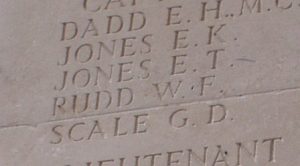
John Parry Jones, Lance Sergeant, 290651, Royal Welsh Fusiliers. John was the son of Hugh and Catherine Jones of 1, Glanllyn Terrace, Barmouth. He enlisted at Barmouth into the 7th Battalion, Royal Welsh Fusiliers on 21 September 1914. The battalion was a Territorial unit, which mobilised for war at Newtown in August 1914, as part of North Wales Brigade, Welsh Division and moved to Conway until the end of the month, before moving to Northampton. In December the Division moved to Cambridge and then in May 1915 to Bedford, where the Division was numbered and the formation became 158 Brigade, 53rd (Welsh) Division. On 19 July 1915 the entire Division sailed from Devonport for Imbros and on 9 August 1915 landed at Suvla Bay. The Division was eventually evacuated from Gallipoli in December 1915, moving to Egypt to join the EEF, and helped guard the Suez Canal before taking part in operations to drive the Turks out of the Sinai. The EEF then turned its attention onto driving the Turks out of Palestine, and on 26 March 1917 launched its first offensive against the coastal city of Gaza, which guarded the road to Jerusalem. Initial gains during the day were lost when the assaulting divisions lost touch with each other and communication broke down when a thick fog cloaked the battlefield. A second offensive against Gaza was launched on 17 April but again failed, causing the commander of the EEF to be replaced by Sir Edmund Allenby. John was wounded during fighting around Shellal on 27 October, and was evacuated to El Arish War Hospital in Egypt where he died of his wounds on 30 October 1917, aged 26. He is buried in Kantara War Memorial Cemetery, Egypt.

John Richard Jones, Private, 736609, Canadian Infantry. John was born at Barmouth on 24 November 1891, the son of William and Dorothy Ann Jones, of Tanygrisiau. He had emigrated to Canada prior to the war and worked as a teamster at Lethbridge, Alberta. John enlisted at Lethbridge into the 113th Battalion, Canadian Infantry on 7 March 1916 and sailed from Halifax for England aboard the SS Tuscana on 25 September 1916. After six months in England, on 16 March 1917 John embarked for France with the 85th Battalion, Canadian Infantry. The battalion was attached to the 11th Brigade, 4th Canadian Division and moved to the Arras sector, facing the German held Vimy Ridge. John took part in the Canadian assault on Vimy Ridge on 9 April 1917, but saw heavy casualties among his battalion. The battalion remained in the line for a while after the capture of the Ridge, before being relieved and transferred to the 12th Brigade in the same Division. During the coming months the Division remained in the same sector, carrying out the normal system of rotation in the line. John was admitted to the 18th General Hospital, Camiers on 28 June 1917, after receiving wounds to his face and hands, and after recovering re-joined his battalion on 6 November, which had by then moved to Ypres, where it had taken part in the capture of Passchendaele Ridge. During the final year of the war the Division took part in the Battle of Amiens, which saw the willpower of the Germans broken, and then took part in the great offensive towards the Hindenburg Line. John was killed in action on 10 August 1918, during the Battle of Amiens. The 26-year-old has no known grave and is commemorated on the Vimy Memorial, France.
Philip Allsworth Jones, Second Lieutenant, King’s Royal Rifle Corps. Philip was born in Wickhambrook, Suffolk in 1885, the son of Dr John Matthews Jones and Georgina Jones. By 1891 the family was living at Glyn Ceiriog. By 1911 Philip was living in Cardiff, where he worked as a bank cashier and he married Mary Winifred Hertz in Cardiff in 1913, before the couple moved to Barmouth, where Philip had taken up a position in the London and Midland Bank. Philip enlisted at Bristol into the Gloucestershire Regiment, but was then commissioned into the 21st Battalion, King’s Royal Rifle Corps. The battalion had moved to Aldershot in January 1916, joining 124 Brigade, 41st Division and on 4 May 1916 landed in France, moving to the Ploegsteert sector for trench initiation. The Division remained here until 7 September 1916, when it moved south to the Somme, to take part in the Battle of Flers-Courcelette. On 14 September the 21st KRRC moved into assembly trenches in Delville Wood and on the following morning launched an assault against Switch Trench, near Gueudecourt. Among the heavy casualties suffered by the battalion during the day was Philip, who had been shot in both legs. He was carried in to an Aid Post before being taken back to the Field Hospital at Heilly, where he died of his wounds on 27 September 1916, aged 30. He is buried in Heilly Station Cemetery, Mericourt-L’abbe, France. Philip is not commemorated at Barmouth, but on the Glyn Ceiriog War Memorial. One of his two sons, Lewis, was killed in 1940, while the other son, Leonard, was awarded the Military Cross in 1944.
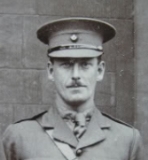
Robert Jones, Driver, M2/194149, Royal Army Service Corps. Robert was born in Barmouth in 1875. He married Mary Ann Roberts on 23 November 1898. Robert worked as a Chauffeur prior to the war and had moved his family to 48, Pen-y-Bryn, Wrexham prior to the war. He enlisted into the Army Service Corps at Wrexham on 24 June 1916 and was posted to the Depot at Grove Park. Robert remained on home service with 621 Motor Transport Company, Army Service Corps for the next six months, but his health had deteriorated, and he was discharged from the army as medically unfit on 28 March 1917. He returned to Wrexham where he died of tuberculosis on 22 July 1918, aged 42. Robert was buried in Wrexham Cemetery. His son, Robert Thomas Jones, was killed in 1918. Neither man is commemorated at Barmouth.
Robert Thomas Jones, Private, 36471, Border Regiment. Robert was born at Barmouth in 1898, the son of Robert Jones and Mary Ann Jones (nee Roberts). When he was young, his parents moved to 48, Pen-y-Bryn, Wrexham. Robert enlisted in Wrexham into the army and was posted to the 5th Battalion, Border Regiment. The battalion had been in France since October 1914 and in May 1915 had become attached to 149 Brigade, 50th (Northumbrian) Division. The battalion had taken part in the Somme offensive in 1916 and in 1917 fought in the Battle of Arras and during the Passchendaele offensive. On 12 February 1918 the 5th Border Regiment was transferred to the 66th (East Lancs) Division, becoming the Divisional Pioneers. The Division then moved to the Somme sector, and suffered heavy casualties during the German offensive of 21 March 1918, causing it to be reduced to a training cadre. The 5th Border Regiment then transferred to 97 Brigade, 32nd Division on 7 May 1918. Following the epic Australian success at Villers Brettoneux on 8 August, the Allies went on the offensive and the 32nd Division took part in the great offensive from 21 August onwards. Robert was killed in action during the Battle of the St Quentin Canal on 1 October 1918, aged 20. He has no known grave and is commemorated on the Vis-en-Artois Memorial, Haucourt, France. His father Robert had only died three months previously. Neither man is commemorated at Barmouth.
Robert Lloyd, Private, 2782, Royal Welsh Fusiliers. Robert was the son of Hugh and Gwen Lloyd, of 5, Tai Isa, Barmouth. He lived at 2, Mount Pleasant, Barmouth prior to enlisting at Newtown into the 7th Battalion, Royal Welsh Fusiliers on 12 August 1914. The battalion was a Territorial unit, which mobilised for war at Newtown in August 1914, as part of North Wales Brigade, Welsh Division and moved to Conway until the end of the month, before moving to Northampton. In December the Division moved to Cambridge and then in May 1915 to Bedford, where the Division was numbered and the formation became 158 Brigade, 53rd (Welsh) Division. On 19 July 1915 the entire Division sailed from Devonport for Imbros and on 9 August 1915 landed at Suvla Bay. Robert survived the terrible campaign at Gallipoli, but prior to the Division being evacuated, was hospitalised with frostbite and returned home. He recovered from his frostbite but was found to be suffering from heart disease and was discharged as medically unfit from Park Hall Camp on 17 August 1916. Undeterred, Robert re-enlisted into the Royal Welsh Fusiliers, gaining the new service number of 70030, and was posted to France to join the 14th Battalion, Royal Welsh Fusiliers, which was attached to 113 Brigade, 38th (Welsh) Division. He would have fought with the Division during the great offensive towards the Hindenburg Line, which ultimately won the war, and was demobilised from the army on 3 May 1919. Robert then went to work in Liverpool, and married a war widow, Alice Smallshaw (nee Graham), of 30, Balfour Street, Anfield. He died of disease on 27 April 1920, aged 27, and was buried in Anfield Cemetery, Liverpool. Robert is not commemorated by the CWGC.
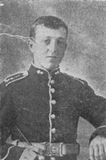
Francis Morris, Private, 2917, Royal Welsh Fusiliers. Francis was the son of Ellis Morris (Harbour Master) and Jane Morris, of Abermawr Terrace, Barmouth. He enlisted at Barmouth into the 7th Battalion, Royal Welsh Fusiliers soon after the outbreak of war. The battalion was a Territorial unit, which mobilised for war at Newtown in August 1914, as part of North Wales Brigade, Welsh Division and moved to Conway until the end of the month, before moving to Northampton. In December the Division moved to Cambridge and then in May 1915 to Bedford, where the Division was numbered and the formation became 158 Brigade, 53rd (Welsh) Division. On 19 July 1915 the entire Division sailed from Devonport for Imbros and on 9 August 1915 landed at Suvla Bay. The infantry moved off the beaches into the bush, but due to a lack of maps and no knowledge of the terrain, many of the units became disorientated, and the situation became chaotic. Francis was killed in action on the following day, 10 August 1915, aged 22. He has no known grave and is commemorated on the Helles Memorial, Gallipoli
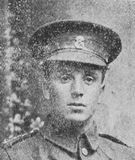
Hugh Cynhaiarn Morris, Fourth Officer, Mercantile Marine. Hugh was the son of Captain Hugh Morris and Laura Jones Morris, of Glyndwr, Barmouth. He served with the Mercantile Marine aboard the Elder Dempster steamship SS Benue. Hugh’s ship was anchored at Sierra Leone in September 1918 when Hugh became ill, and he died there on 16 September 1918, aged 35. Nothing further is known of him as he is not commemorated by the CWGC. His brother John was killed at Mametz Wood in 1916.
John Morris, Private, 34960, Royal Welsh Fusiliers. John was the son of Captain Hugh Morris and Laura Jones Morris, of Glyndwr, Barmouth. He worked as a milkman in London prior to the war and enlisted at Holborn into the 18th Battalion, Royal Welsh Fusiliers (2nd London Welsh) on 18 November 1915. On 7 April 1916 he embarked for France, joining the 38th Infantry Base Depot, before being posted to the 16th Battalion, Royal Welsh Fusiliers on 20 April, joining the battalion at Merville, where it was attached to 113 Brigade, 38th (Welsh) Division. On 1 May the battalion moved back into the line at Laventie, and John had his first taste of life in the trenches. During the last week of June the Division left the sector and began to move south to the Somme, to take part in the great offensive which would be launched there on 1 July 1916. By 6 July the Division was at Carnoy, and was preparing to launch its first assault on Mametz Wood. The attack was launched on 7 July by 115 Brigade, but failed due to inadequate artillery support, and as a result the Divisional Commander, Sir Ivor Philipps was replaced, before the Division attacked again at dawn on 10 July. Heavy fighting raged in the wood over the coming days, and the Division suffered terrible casualties before being relieved on 12 July. John had been reported as missing in action on 11 July 1916. He was later adjudged to have been killed in action on that date. The 24-year-old was originally buried near White Trench, to the south of the wood, but after the war his grave, together with that of Sergeant Ellis, was exhumed and reburied in Dantzig Alley British Cemetery, Mametz, France. His brother, Hugh, died in 1918 while serving with the Mercantile Marine.
William Morris, Captain, West Yorkshire Regiment. William was born on 26 May 1882, the son of John and Elizabeth Morris of Tan-y-Fedw, Barmouth. He was educated at the County School and worked as a house painter prior to the war. William enlisted into the Royal Welsh Fusiliers on 14 October 1914, and was promoted to Lance Corporal before being commissioned into the West Yorkshire Regiment on 16 November 1915. After training as an officer, he embarked for France on 19 July 1916, joining the 12th Battalion, West Yorkshire Regiment. The battalion was on the Somme attached to 9 Brigade, 3rd Division, and took part in the early stages of the Somme offensive at the Battle of Albert. The Division then saw heavy fighting at the Battle of Bazentin, where it captured Longueval. William was among a number of officers who joined the battalion here, to make up for heavy losses in the capture of the village. The Division then took part in the Battle of Delville Wood, before the Division moved to the area of Noeux-les-Mines. Early in October the Division returned to the Somme to take part in the Battle of the Ancre, and took part in the attack on Lonely Trench that month. The Division moved to the Arras sector the following year. William was wounded in the head during an attack on the German trenches facing Noisy Redoubt, near Tilloy, on 9 April 1917 and evacuated to the Hospital at Étaples, where he died of his wounds on 14 April 1917, aged 34. William is buried in Étaples Military Cemetery, France.
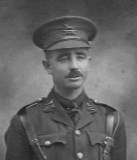
William Edmund O’Neill, Sergeant, 7022, Suffolk Regiment. William was born in Buttervant, Cork in 1890, the son of Edmund and Elizabeth O’Neill (nee Humphreys). His father who was a soldier, died in 1895, and his mother, who was from Dinas Mawddy, remarried another soldier, Lieutenant Robert Felstead. Robert was then posted to India, taking his new family with him, but by 1902 was back in England. He died in Cambridge on 9 November 1902, so Elizabeth moved back to Wales with her family, settling at 5, Brynawel Terrace, Barmouth. William had enlisted into the 1st Battalion, Suffolk Regiment prior to 1911, and was in Cairo with his battalion by March that year. At the outbreak of war the battalion was in Khartoum and on 23 October 1914 landed at Liverpool. The battalion then moved to Winchester to join 84 Brigade, 28th Division and on 18 January 1915 landed at Le Havre before moving to Ypres. William had only been at Ypres three weeks when he was killed in action on 16 February 1915, aged 25. He has no known grave and is commemorated on the Ypres (Menin Gate) Memorial, Belgium.
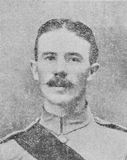
John Owen, Gunner, 77026, Royal Garrison Artillery. John was the son of Owen David Owen and Mary Owen of Ecclefechan, Water Street, Barmouth. He worked as a gardener prior to enlisting at Dolgellau into the Royal Garrison Artillery on 11 December 1915, and was posted to No 2 Depot at Gosport, Hampshire for training. On 19 May 1916 John was posted to France with the 133rd Siege Battery, Royal Garrison Artillery. He served for over a year on the Western Front, before his battery was posted to the Belgian Coast. On 8 August 1917 John’s battery came under shellfire from the Germans, and John and a Gunner Davies were wounded. Gunner Davies died that same day, while John died of his wounds on the following day at the Canadian Casualty Clearing Station on 9 August 1917, aged 20. He is buried in Adinkerke Military Cemetery, Belgium.

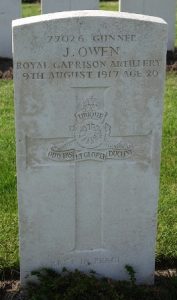
William Robert Owen, Private, 291073, Royal Welsh Fusiliers. William was the illegitimate son of Elizabeth Owen, of Dyffryn, Barmouth. He was raised by his Aunt, Mrs Susannah Jones, at Trawsfynydd, before rejoining his mother at some time prior to 1911, as they were living as tenants at Caemawr, Ganllwyd. He enlisted at Dolgellau on 23 April 1915 into the 2/7th Battalion, Royal Welsh Fusiliers and was posted to Northampton with the battalion. On 26 June 1915 William was transferred to the 1/7th Battalion, Royal Welsh Fusiliers. The battalion was a Territorial unit, which mobilised for war at Newtown in August 1914, as part of North Wales Brigade, Welsh Division and moved to Conway until the end of the month, before moving to Northampton. In December the Division moved to Cambridge and then in May 1915 to Bedford, where the Division was numbered and the formation became 158 Brigade, 53rd (Welsh) Division. On 19 July 1915 the entire Division sailed from Devonport for Imbros and on 9 August 1915 landed at Suvla Bay. The Division was eventually evacuated from Gallipoli in December 1915, moving to Egypt to join the EEF, and helped guard the Suez Canal before taking part in operations to drive the Turks out of the Sinai. The EEF then turned its attention onto driving the Turks out of Palestine, and on 26 March 1917 launched its first offensive against the coastal city of Gaza, which guarded the road to Jerusalem. The battle was a failure for the EEF, and a second assault on Gaza was launched on 17 April which also failed, resulting into the Commander of the EEF being replaced by Sir Edmund Allenby. He reorganised the EEF before launching a third offensive on a wider front, from Beersheeba to Gaza, on 6 November 1917, which broke the Turkish lines. William was killed in action that day, during the Third Battle of Gaza. The 22-year-old is buried in Beersheba War Cemetery, Israel.
Jack Arthur Percival Perkins, Private, 49788, Cheshire Regiment. Jack was born in Wolstanton, Staffordshire in 1896, the son of Arthur and Catherine Perkins. By 1914 the family was residing at Noddfa, Barmouth. Jack enlisted at Rhyl into the 2nd Battalion, Denbighshire Yeomanry on 5 April 1915, and joined the battalion in Newcastle, where it was attached to the 2/1st Welsh Border Mounted Brigade. In November 1915 the Brigade moved to Yorkshire and in March 1916 the brigade became the 17th Mounted Brigade, joining the 1st Mounted Division in East Anglia. On 3 October 1916 Jack was posted to the 1st Battalion, Cheshire Regiment, which was in France attached to 15 Brigade, 5th Division. The Division had just moved to Festubert to rebuild, having suffered heavy casualties on the Somme, and in March 1917 moved to the Arras sector, taking part in the Battle of Vimy in April 1917. On 3 May the Division fought in the Third Battle of the Scarpe, and captured Oppy Wood, then on 7 September moved north to take part in the Passchendaele offensive. By now the British had selected five Divisions to be sent to Italy, to aid the Italians following their defeat at Caporetto, and by late January 1918 the 5th Division had taken up positions along the River Piave. Jack was wounded within weeks, and died of his wounds at the 24th Casualty Clearing Station, Italy on 11 March 1918, aged 21. He is buried in Giavera British Cemetery, Arcade, Italy. Jack is not commemorated on the Barmouth memorial.
Ernest Powell, Private, 290893, Royal Welsh Fusiliers. Ernest was born in Lulsey, Worcestershire in 1882. By 1911 he was living at 1, Brynawel Terrace, Barmouth, where he worked as a gardener. He enlisted at Barmouth on 7 December 1914 into the 7th Battalion, Royal Welsh Fusiliers. The battalion was a Territorial unit, which mobilised for war at Newtown in August 1914, as part of North Wales Brigade, Welsh Division and moved to Conway until the end of the month, before moving to Northampton. In December the Division moved to Cambridge and then in May 1915 to Bedford, where the Division was numbered and the formation became 158 Brigade, 53rd (Welsh) Division. On 19 July 1915 the entire Division sailed from Devonport for Imbros and on 9 August 1915 landed at Suvla Bay. The Division remained at Gallipoli until December, seeing heavy casualties during its first weeks there. Ernest was hospitalised with frostbite around the time of the evacuation and on 26 January 1916 sailed back to Britain for treatment. It was 12 March 1917 before he was fit enough to return to the front, and was posted to France, joining the 2nd Battalion, Royal Welsh Fusiliers, which was attached to 19 Brigade. Ernest then saw action with the battalion at the Battle of Arras, and then during the Passchendaele offensive later that year, and was wounded at Polygon Wood in September 1917, returning to Britain once more. He was then posted out to Palestine, joining the 25th Battalion, Royal Welsh Fusiliers, which was attached to the 74th (Yeomanry) Division. The Division was transferred to France in May 1918, to help bolster the British army, following its heavy losses during the German offensives of March and April, and moved to the St. Hilaire sector. In July the Division moved to the St. Floris sector and remained there until moving to the Somme at the end of August, to take part in the great offensive. By 18 September 1918 the Division was in position near Épehy and that morning launched an assault against several heavily defended German positions in front of the Hindenburg Line. Ernest was killed during fighting at Benjamin Post that day. He was 36 years old and is buried in Ronssoy Communal Cemetery, France.
William Pritchard, Private, 1364, Welsh Guards. William was born in Barmouth in 1893, the son of John and Ann Pritchard. His father was a signalman for Cambrian Railways and by 1901 the family had moved to Tywyn. By 1911 the family had moved to Welshpool and William worked there as a railway porter, prior to enlisting into the Merionethshire Police in April 1914 and was posted to Barmouth. In May 1915 William enlisted into the newly formed Welsh Guards, which had been raised by Royal Warrant of 26 February 1915, at White City. The Welsh Guards landed at Le Havre on 18 August 1915, becoming attached to 3rd Guards Brigade, Guards Division. The Division saw its first major action during the Battle of Loos, which began on 25 September 1915, and also fought in the subsequent Action of Hohenzollern Redoubt. The Guards Division wintered at Ypres and on 27 July 1916 left Ypres for the Somme. The Guards attacked the village of Ginchy on 9 September, and its subsequent capture paved the way for an assault on Flers-Courcelette. The Welsh Guards moved into Trônes Wood on 14 September, and saw for the first time the new super-weapon, the tank, which was about to make its debut on the battlefield. At 01.00 on 16 September 1916 the Welsh Guards received their orders to attack, and at midday the assault was launched, in terrible weather. William was killed in action during the heavy fighting that afternoon. The 24-year-old has no known grave and is commemorated on the Thiepval Memorial, France. William is not commemorated on the Barmouth memorial.
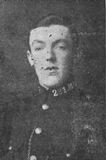
Robert Griffith Rees, Lieutenant, Royal Welsh Fusiliers. Robert was born in Hackney in 1889, the son of Reverend William Rees and Ellen Cordelia Rees. The family then moved back to Ellen’s native Barmouth for several years before moving to Pontypridd. Robert enlisted into the Royal Welsh Fusiliers under the name of Roland Gwyn Rees soon after the outbreak of war and was commissioned into the 15th Battalion, Royal Welsh Fusiliers in February 1915. The battalion was at Llandudno attached to 128 Brigade, 43rd (Welsh) Division and trained in North Wales before moving to Winchester in the summer of 1915, where the formation became renumbered 113 Brigade, 38th (Welsh) Division. The Division moved to France on 2 December 1915 and moved to the Nursery Sector near Fleurbaix for trench initiation alongside the Guards Division. The Division then held a sector of the line near Cuinchy before marching south to the Somme sector in June 1916 to take part in the assault on Mametz Wood. The first assault was launched on a two-battalion front on 7 July 1916 but failed, suffering terrible casualties, and the Divisional Commander, Sir Ivor Philipps, was replaced before the Division attacked again on 10 July 1916. Robert was killed in the wood whilst fighting with B Company during the day. He was 25 years old. His remains were found buried near White Trench in 1931, and he was identified by his RWF flash, rank insignia and his leather holster, with his name stamped on. He was re-buried in Serre Road Cemetery No.2, France.
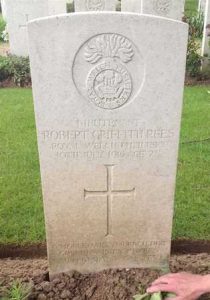
David Richards, Pioneer, WR/42149, Royal Engineers. David was the son of David and Gwen Richards, of Ynyscynhaiarn. He married Elizabeth Jones on 2 December 1899 and the couple lived at Marine Terrace, Barmouth. He worked as a labourer in Abertysswg prior to the war and returned to Barmouth to enlist into the 16th Battalion, Royal Welsh Fusiliers on 17 December 1914. The battalion was raised at Llandudno by the Welsh National Executive Committee from a cadre from the 13th Battalion, joining 128 Brigade, 43rd (Welsh) Division and trained in North Wales before moving to Winchester in the summer of 1915, where the formation became renumbered 113 Brigade, 38th (Welsh) Division. The Division moved to France on 2 December 1915 and moved to the Nursery Sector near Fleurbaix for trench initiation alongside the Guards Division. The Division then held a sector of the line near Cuinchy before marching south to the Somme sector in June 1916 to take part in the assault on Mametz Wood. After its successful capture of the wood, the Division was posted to the Canal Bank sector north of Ypres, where it remained until its famous assault on Pilckem Ridge, as part of the opening of the Third Battle of Ypres. David health had by then started to suffer though, and he returned home during July 1917, being posted to the 3rd RWF. In April 1918 he was transferred to the Roads and Quarries Companies of the Royal Engineers and was posted to Bordon. He was home on leave when he fell from a window of his home at Leamington Hose, Barmouth, and died of concussion on 10 November 1918, aged 44. He is buried in St. Mary’s Churchyard, Llanaber.
Arthur Wilson Roberts, Lance Corporal, 1354, Australian Infantry. Arthur was born at Llanberis in 1885, the son of Lewis Wilson Roberts and Margaret Ellen Roberts. By 1901 the family was living at 9, Porkington Terrace, Barmouth, and Arthur received his education at the Barmouth County School, and then trained as a carpenter. He had emigrated to Canada several years before the outbreak of war and had visited home before emigrating to Australia in 1913. Following the outbreak of war he enlisted at Rockhampton, Queensland into the 15th Battalion, Australian Infantry on 17 November 1914. He embarked at Melbourne with the 1st Reinforcements for the battalion aboard HMAT Berrima on 22 December 1914 and joined the battalion in Egypt. Arthur took part in the Gallipoli Landings on 25 April 1915 and was wounded the following month. He was evacuated by Hospital Ship to Cyprus where he was treated and on 25 August re-joined the battalion at Gallipoli. At the end of December 1915, the battalion was evacuated from Gallipoli to Alexandria, where the 15th Battalion became part of the 4th Australian Division, and in June 1916 the 4th Division moved to the Western Front from Egypt, taking up the line in the Nursery Sector near Fleurbaix. The Division then moved south to the Somme and in August 1916 relieved the 2nd Australian Division at Pozieres. Arthur was killed in action during an assault by the 15th Battalion at Pozieres on 9 August 1916. The 31-year-old has no known grave and is commemorated on the Villers-Bretonneux Memorial, France.
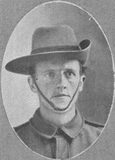
Cadwalader Glyn Roberts, Lieutenant, Royal Welsh Fusiliers. Cadwalader was born in Llanfairfechan on 31 August 1894, the son of Reverend Peter Jones Roberts and Sarah Ellen Roberts. The family then moved to Epworth Villa, Barmouth, where Cadwaladr was raised before leaving the town to be educated at Ysgol Friars School, Conwy. He won a scholarship to Bangor University in 1912. Cadwaladr enlisted into the 14th Battalion, Royal Welsh Fusiliers on 1 November 1914, and was soon commissioned as an officer on 19 February 1915. The battalion was attached to 113 Brigade, 38th (Welsh) Division, and landed in France on 4 December 1915, proceeding to the Nursery Sector near Laventie for trench initiation alongside the Guards Division. At some time after this Cadwaladr was posted to the 9th Battalion, Royal Welsh Fusiliers, which was attached to 58 Brigade, 19th (Western) Division. Cadwaladr’s qualities soon brought him to the notice of his CO and he was soon promoted to Lieutenant and made Adjutant to the battalion. The Division moved to the Somme sector at the end of April and began training for the forthcoming offensive. The Battle of the Somme opened on 1 July 1916, and the 19th Division was in reserve to the 8th and 34th Divisions, which had been given the task of capturing the village of La Boiselle, on the Albert to Bapaume road. Both divisions suffered terrible casualties on the opening day, so the 19th Division was ordered forward and at dawn on 2 July launched their attack. Heavy fighting raged all day, but the 9th RWF gained control of the village and held it throughout the night. Cadwaladr was killed in action on the following day, 3 July 1916. The 21-year-old is buried in Ovillers Military Cemetery, France.
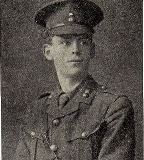
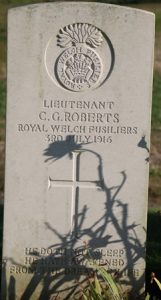
Robert Henry Roberts, Private, 3005, Royal Welsh Fusiliers. Robert was the son of Hugh and Ellen Roberts, of Pentre Du Crossing, Aber, Bangor. He lived in Penlan, Barmouth prior to the war and worked as assistant manager in the Star Stores in the town. In September 1914 Robert was offered the post of manager of the Star Stores in Dolgellau, but turned the position down to enlist into the 7th Battalion, Royal Welsh Fusiliers. The battalion was a Territorial unit, which mobilised for war at Newtown in August 1914, as part of North Wales Brigade, Welsh Division and moved to Conway until the end of the month, before moving to Northampton. In December the Division moved to Cambridge and then in May 1915 to Bedford, where the Division was numbered and the formation became 158 Brigade, 53rd (Welsh) Division. On 19 July 1915 the entire Division sailed from Devonport for Imbros and on 9 August 1915 landed at Suvla Bay. The infantry moved off the beaches into the bush, but due to a lack of maps and no knowledge of the terrain, many of the units became disorientated, and the situation became chaotic. Robert was killed on the following day, 10 August 1915, aged 24. He has no known grave and is commemorated on the Helles Memorial, Gallipoli.
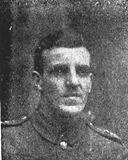
Arthur Ross, Private, 40652, Suffolk Regiment. Arthur was the son of Joseph and Harriett Ross of 236, High Street, Bloxwich, Walsall. He married Priscilla Wood in 1906, and the couple set up home at 54A, Blakenall Heath, Bloxwich, where their two sons were born. By 1914 the family was living at Auckland House, Marine Parade, Barmouth. Arthur enlisted at Walsall into the Suffolk Regiment, and was posted to France at some time in 1916, joining the 7th Battalion, Suffolk Regiment, which was attached to 35 Brigade, 12th (Eastern) Division. The Division moved from the Loos sector to the Somme in March 1916 and took part in the attack on Ovillers on 2 July 1916. It saw further fighting throughout the offensive before moving to the Arras sector during October 1916. During March 1917 the Division took part in the Battle of Arras. On 25 April 1917 the Division moved back into the front line at Arras, relieving the 17th Division and prepared for an assault on the village of Pelves. At 04.28 on 28 April 1917, 35 Brigade attacked the village, but got caught by heavy artillery and machine-gun fire and their attack failed. Arthur was killed in action during the days fighting. The 38-year-old has no known grave and is commemorated on the Arras Memorial, France. He is not commemorated on the Barmouth memorial, although his widow, Priscilla, continued to live in the town until her death on 15 February 1947.
Alfred James Strongman, Sergeant, 290629, Royal Welsh Fusiliers. Alfred was born in Market Harborough in 1894, the son of John Edwin Strongman and Elizabeth Strongman. By 1911 the family was living at The Haven, Barmouth. He worked as an upholsterer prior to the war and enlisted at Barmouth on 10 October 1914 into the 7th Battalion, Royal Welsh Fusiliers. He was posted to the 2/7th Battalion, Royal Welsh Fusiliers, which was attached to 203 Brigade, 68th (Welsh) Division at Northampton. The Division moved to Bedford in July 1915 Bedford, and spent over a year there before moving to Southwold. By the spring of 1917 the Division was at Henhain Park, Halesworth, and Alfred had reached the rank of Sergeant. He was selected to go to East Africa to help train the King’s African Rifles, and embarked on 19 May 1917. Upon his arrival he joined the regiment in East Africa, but was had not been in Africa long when he was wounded in action on 3 August 1917, dying the same day. He was 23 years old and was buried in Mingoyo Cemetery, Tanzania. He is commemorated by a Special Memorial gravestone in Dar Es Salaam War Cemetery, Tanzania.
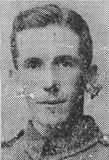
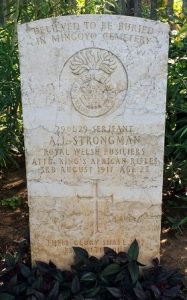
Evan Thomas, Private, 61036, Royal Welsh Fusiliers. Evan was the son of Owen and Elizabeth Thomas, of 4, Graigydon Cottage, Barmouth. He was called up for military service early in 1917, and took the case to the Military Appeal Tribunal for exemption but was refused, so enlisted at Dolgellau into the 3rd Battalion, Royal Welsh Fusiliers. Evan was posted to Ireland with the battalion on Garrison duties. He fell ill in Ireland and died of disease in hospital in Limerick on 18 January 1918, aged 25. His body was returned home and he was buried in St. Enddwyn’s Churchyard, Llanenddwyn.
Robert Thomas, Private, 291046, Royal Welsh Fusiliers. Robert was the son of Robert and Stella Elizabeth Thomas, of 4, Church Place, Barmouth. He enlisted at Barmouth into the 7th Battalion, Royal Welsh Fusiliers on 27 March 1915 and was posted to the 2/7th Battalion, Fusiliers, which was attached to 203 Brigade, 68th (Welsh) Division at Northampton. The Division moved to Bedford in July 1915 Bedford, and spent over a year there before moving to Southwold. On 5 January 1916 Robert was posted to the 3/7th Battalion, Royal Welsh Fusiliers, which was at Park Hall, Oswestry and on 16 June 1917 embarked for France to join the 15th Battalion, Royal Welsh Fusiliers, which was attached to 113 Brigade, 38th (Welsh) Division. He joined the battalion at the Canal Bank sector, north of Ypres, where the Division was preparing to launch its offensive against the Pilckem Ridge. On 29 June the battalion came out of the line to carry out a training schedule in preparation for the assault, and did not return into the line until 23 July. On the morning of 27 July 1917, four days before the offensive, orders were given to the 15th RWF to advance and investigate Royal Flying Corps reports that the Germans had withdrawn. The battalion sent out a patrol, but the reports were incorrect, and the patrol came under heavy fire, causing heavy losses among A and D Companies. Robert was among the dead that day. The 21-year-old has no known grave and is commemorated on the Ypres (Menin Gate) Memorial, Belgium.

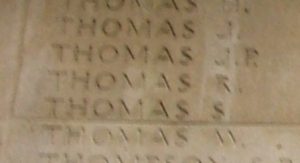
William Thomas, Serjeant, 13289, South Wales Borderers. William was born in Barmouth and had served with the Royal Welsh Fusiliers during the Boer War. By the time the Great War began, he lived with his wife, Sarah Ann Thomas, at Burry Cottages, Penclawdd. He re-enlisted at Tonyrefail into the 4th Battalion, South Wales Borderers, which was attached to 40 Brigade, 13th (Western) Division. In July 1915 the 13th Division was sent to the Mediterranean to join the Gallipoli campaign and landed at Cape Helles. Two weeks later the division was moved to the ANZAC sector to take part in an assault on the Sari Bair ridge. At 08.00 on 6 August the offensive began and the 4th Battalion led the way forward, reaching the summit of Achyl Dere before attaining its objective, the ridge named Damakjelic Bair. On 9 August 1915 the Turks counter-attacked, and among the first to fall was Lieutenant Colonel Gillespie, the CO of the 4th SWB. William was also killed in action during the days fighting. He has no known grave and is commemorated on the Helles Memorial, Gallipoli. William is not commemorated on the Barmouth memorial, but at Penclawdd, near Swansea.

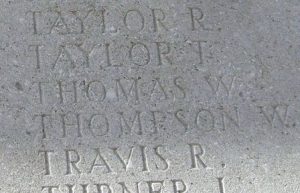
Albert Cecil Tyler, Gunner, 131370, Royal Garrison Artillery. Albert was born ay Ystradgynlais in 1883, the son of George and Caroline Tyler. By 1911 the family had moved to Barmouth, after George had become head gardener at Orielton Hall Gardens, and lived at Brynmynach Lodge, Barmouth. By 1914 Albert was living in Ballybay, Co. Monaghan, and following his fathers profession, was Head Gardener at Ballybay House. He married Sarah Rutldege in December 1914 and the couple had two daughters. Albert enlisted at Monaghan into the Royal Garrison Artillery on 3 October 1916 and was posted to The Citadel at Plymouth for training. On 23 March 1917 he embarked for France and joined the 115th Siege Battery, Royal Garrison Artillery. By 20 May he had taken ill and returned to England for treatment, before returning to France, joining the 99th Siege Battery, Royal Garrison Artillery. Albert was wounded on the Lys in May 1918 and died in Hospital at Aire on 30 May 1918, aged 35. He is buried in Aire Communal Cemetery, France. The memorial states Herbert Tyler, Royal Welsh Fusiliers, but is incorrect.
George Cuthbert Vaughan, Lance Corporal, 18680, Royal Welsh Fusiliers. George was the son of of Charles William Vaughan and Emma Vaughan, of Grove Villa, Minsterley. He lived at Glandwr Mill, Barmouth prior to the war and enlisted at Barmouth into the 16th Battalion, Royal Welsh Fusiliers. The battalion was raised at Llandudno by the Welsh National Executive Committee from a cadre from the 13th Battalion, joining 128 Brigade, 43rd (Welsh) Division and trained in North Wales before moving to Winchester in the summer of 1915, where the formation became renumbered 113 Brigade, 38th (Welsh) Division. The Division moved to France on 2 December 1915 and moved to the Nursery Sector near Fleurbaix for trench initiation alongside the Guards Division. The Division then held a sector of the line near Cuinchy before marching south to the Somme sector in June 1916 to take part in the assault on Mametz Wood. The Divisions first assault was launched on 7 July on a two battalion front, but was beaten off with heavy losses due to poor artillery support, and machine-gun fire cutting the men down in No Man’s Land. The Divisional Commander, Sir Ivor Philipps, was replaced and the Division attacked again on a two brigade front on 10 July 1916. Fighting raged within the wood over the coming days, and on 12 July the Division was relieved after having reached the northern edge of the wood. George had been killed during intense fighting in the wood on 11 July 1916. The 24-year-old has no known grave, and is commemorated on the Thiepval Memorial, France.

Charles Stanley Walker, Sergeant, 18674, Royal Welsh Fusiliers. Charles was the son of George and Hannah Walker, of 3, Dudley Road, Sefton, Liverpool. He worked as a Hotel Porter prior to coming to Barmouth, and worked at the Gorsycedol Hotel, Barmouth prior to the war and enlisted at Barmouth into the 16th Battalion, Royal Welsh Fusiliers soon after the outbreak of war. The battalion was raised at Llandudno by the Welsh National Executive Committee from a cadre from the 13th Battalion, joining 128 Brigade, 43rd (Welsh) Division and trained in North Wales before moving to Winchester in the summer of 1915, where the formation became renumbered 113 Brigade, 38th (Welsh) Division. The Division moved to France on 2 December 1915 and moved to the Nursery Sector near Fleurbaix for trench initiation alongside the Guards Division. The Division then held a sector of the line near Cuinchy before marching south to the Somme sector in June 1916 to take part in the assault on Mametz Wood. The Divisions first assault was launched on 7 July on a two-battalion front, but was beaten off with heavy losses due to poor artillery support, and machine-gun fire cutting the men down in No Man’s Land. The Divisional Commander, Sir Ivor Philipps, was replaced and the Division attacked again on a two-brigade front on 10 July 1916. Charles survived the carnage of Mametz Wood, and moved with the Division to the Canal Bank sector north of Ypres following its withdrawal from the Somme. The Divisions battalions then began the normal pattern of rotating in the front line. On 1 December the 16th RWF moved into the left sub-sector along the Canal Bank to begin another tour. By the time it was relieved on 4 December and moved into reserve it had suffered one officer and four men killed and seven more wounded. Charles was among the wounded, and was evacuated to the field hospital at Mendinghem where he died of his wounds on 17 December 1916, aged 24. He is buried in Mendinghem Military Cemetery, Belgium.
Clarence William Anstruther Wilkinson, Private, 41, Australian Infantry. Clarence was born in Diss, Norfolk, the son of Reverend Anthony Anstruther Wilkinson and Harriett Susan Wilkinson. Clarence went to sea as a young man and served with the Mercantile Marine for many years, prior to emigrating to Australia in 1913, and he became a farmer at Helena Valley, Perth. By now his parents had moved to 8, Parkington Terrace, Barmouth. Clarence enlisted into the 16th Battalion, Australian Infantry on 10 September 1914 and trained at Blackboy Hill, before the battalion sailed from Fremantle to Melbourne. On 22 December 1914 the battalion embarked aboard HMAT A40 Ceramic and sailed in convoy with the Australian Imperial Force for Egypt via Ceylon and the Suez Canal. The Australians trained near Cairo over the coming weeks, seemingly intended to move to France, but the plan had now been hatched to attempt to drive Turkey out of the war by forcing the passage of the Dardanelles Straits and seizing Istanbul. An attempt to enter the Black Sea by a combined French and British fleet failed, so on 25 April 1915 the Allies landed forces in several strategic points on the Gallipoli Peninsula, the Australians landing at Anzac Cove. Clarence survived the landings, but was shot in the face soon afterwards and evacuated aboard the Hospital Ship HS Dongola where he died on 5 May 1915, aged 29. He was buried at sea, so is commemorated on the Lone Pine Memorial, Gallipoli. Clarence is not commemorated on the Barmouth memorial.
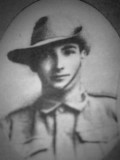

Elias Robert Williams, Private, 291464, Royal Welsh Fusiliers. Elias was born at Corris, the son of John and Sarah Ann Williams. By 1901 the family was living at Murneuadd, Arthog. Elias became a schoolteacher at Barmouth Council School, then by 1911 was teaching at Blaenau Ffestiniog. At the outbreak of war he was teaching at Rhyl Council School. He enlisted at Rhyl into the Royal Welsh Fusiliers on 7 December 1915. He was mobilised on 10 February 1916 and joined the 3/7th Battalion, Royal Welsh Fusiliers at Oswestry. On 3 July 1916 he was posted to Egypt, joining the 1/7th Battalion, Royal Welsh Fusiliers, which was attached to 158 Brigade, 53rd (Welsh) Division. The division had moved to Egypt following service in Gallipoli, to join the EEF, and helped clear the Turks out of Sinai, safeguarding the Suez Canal, before beginning the campaign to capture Palestine in 1917. The division took part in two unsuccessful attacks on Gaza in March and April 1917, before the EEF was re-organised and on the night of 1 November 1917 launched the Third Battle of Gaza. This third assault was a success, which saw Gaza captured and the road to Jerusalem now lay wide open. Elias was wounded during the battle and was evacuated to the hospital in Kantara, where he died of his wounds on 11 November 1917, aged 28. He is buried in Kantara War Memorial Cemetery, Egypt. Elias is also commemorated on the war memorials at Rhyl and Arthog.
Humphrey Evan Wynne Williams, Second Lieutenant, Royal Welsh Fusiliers. Humphrey was the son of David Williams and Elizabeth Jane Wynne Williams, of 45, Redlands Road, Penarth. His mother was the daughter of Humphrey Wynne Williams, Chemist, of Glantraeth, Barmouth. Humphrey enlisted into the Royal Field Artillery soon after the outbreak of war and was soon commissioned into the 10th Battalion, Royal Welsh Fusiliers. The battalion had formed at Wrexham, before moving to Codford St. Mary, joining 76 Brigade, 25th Division. Humphrey was given command of No 4 Platoon, A Company. On 27 September 1915 Humphrey landed in France with the battalion, which moved with the Division to Nieppe. Over the coming days the Division marched through Bailleul to Poperinghe, where 76 Brigade became transferred to the 3rd Division. On 15 October the 10th RWF moved into the trenches in the Ypres Salient for the first time, and began the routine of rotating between front line, reserve and rest. On 21 November the Division took over the sector to the south of the Ypres Salient, near St. Eloi, a particularly hazardous part of the line, where casualties were incurred by the front line troops on a daily basis. On 28 March 1916 it was the turn of the 10th RWF to man the front line again, so the battalion marched via Voormeezele into the line, taking over some recently captured German trenches. Two days later, on 30 March 1916, a raiding party from the battalion attacked a German forward post, suffering a number of casualties. Humphrey was reported to have been killed by a shell whilst trying to bring rations forward to the men that day. He was 18 years old and is buried in Reninghelst New Military Cemetery, Belgium.
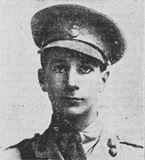
Robert Williams, Private, 85686, Royal Army Service Corps. Robert was the son of Edmund and Margaret Williams, of College, Llwyngwril. He worked as a waiter at Glencairn, Barmouth prior to enlisting into the Royal Army Medical Corps on 2 November 1916, and was posted to Aldershot for training. He soon became ill, and was hospitalised at Connaught Hospital, Aldershot a week after arriving, and spent a week there before re-joining his unit. On 17 July 1917 he was posted to the RAMC Training Centre at Blackpool, before embarking at Southampton for Salonika on 14 September 1917, with No 12 RAMC Reinforcements. On 11 October he disembarked at Salonika and was posted for duty to the 52nd General Hospital. He volunteered to remain in Salonika with the Army of Occupation after the Armistice, but by February his health had broken down, and he was hospitalised again. After recovering he was posted for duty to the 82nd General Hospital at Istanbul on 23 July 1919, but he again fell ill and died of pneumonia at the 82nd General Hospital just a week later, on 31 July 1920, aged 23. He is buried in Haidar Pasha Cemetery, Istanbul. Robert is also commemorated on the Llwyngwril War Memorial.
Thomas Williams, Petty Officer, 222411, Royal Navy. Thomas was born on 19 July 1886, the son of Thomas and Mary Williams, of 1, Glanaber, Terrace, Barmouth. He worked as a warehouse boy prior to enlisting into the Royal Navy on 19 July 1904 and after completing his training at Portsmouth served aboard a wide variety of ships before being posted aboard the armoured cruiser HMS Black Prince following the outbreak of war. She was stationed in the Mediterranean when war erupted and participated in the pursuit of the German battlecruiser SMS Goeben and light cruiser SMS Breslau. She was then sent to the Red Sea to protect troop convoys arriving from India and to search for German merchant ships and after capturing two ships, Black Prince was transferred to the Grand Fleet in December 1914 and was assigned to the 1st Cruiser Squadron. At the end of May 1916 the Admiralty received reports that the German High Seas Fleet had put to sea, so sent out the Grand Fleet in pursuit. The 1st Cruiser Squadron was deployed in front of the main fleet as a screening force, but when the Squadron came into contact with the Germans at around 17.42 on 31 May 1916, contact was lost with Black Prince. Soon afterwards, two other members of the 1st Cruiser Squadron, Defence and Warrior, were engaged by German battleships and battlecruisers, with Defence blowing up and Warrior receiving heavy damage, which later caused her to sink. According to German reports Black Prince was separated from the rest of the fleet and came into contact with the Germans shortly before midnight. Three German battleships opened devastating fire upon her, and she sank within fifteen minutes, with the loss of all of her crew of 857 men. Thomas was 29 years old when he was killed that night, and is commemorated on the Portsmouth Naval Memorial, Hampshire.
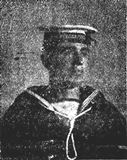
Thomas Lewis Williams, Chief Motor Mechanic, MB/619, Royal Naval Volunteer Reserve. Thomas was born on 14 March 1884, the son of Griffith and Elizabeth Anne Williams, of 1, Beach Road, Barmouth. He worked as a Chauffeur prior to enlisting into the Royal Navy on 14 November 1914 and was posted to HMS Pembroke III, where he trained as a Mechanical Engineer. On 29 October 1915 he was discharged from the Royal Navy and joined the Royal Naval Volunteer Reserve and his first posting was aboard HMS Resource. She was lost by fire soon afterwards, so Thomas was posted to HMS Victory II, then to HME Egmont III, at Port Said, before being posted aboard the protected cruiser HMS Hermione on 20 September 1917. Thomas took ill aboard Hermione, and died of pneumonia on 15 October 1918, aged 33. His body was conveyed home for burial in St. Mary’s Churchyard, Llanaber.
William Williams, Gunner, W/4754, Royal Field Artillery. William was born on 18 February 1893, the son of Owen and Kate Williams, of School House, Barmouth. He worked as a collier and lived with his Aunt, Ann Ellen Williams, at 9, Carnytyla Terrace, Abertysswg prior to the war. William enlisted at Newport into the Royal Field Artillery on 14 May 1915 and was posted to the 38th (Welsh) Divisional Artillery, which was at Winchester, joining C Battery, 121st Brigade, RFA. He landed in France with the Divisional Artillery on 24 December 1915, and the artillery entrained for Northern France, joining up with the Division in the Nursery Sector and took up billets in Merville. The Division held various sectors of the line over the coming months, before moving south to the Somme in June 1916, and from 7 July onwards assaulted the strongly defended Mametz Wood. After being withdrawn from the Somme, the Division took over the Canal Bank sector north of Ypres, and remained there until launching its offensive on the Pilckem Ridge on 31 July 1917. Williams battery was supporting an assault on Langemarck when a German shell crashed nearby, killing him instantly, on 18 August 1917. William was 24 years old and is buried in Canada Farm Cemetery, Belgium.

William Williams, Private, 748574, Canadian Mounted Rifles. William was born at Barmouth on 29 June 1885, the son of George and Elizabeth Hughes Williams, of Goronwy Terrace. Following the early death of his parents, ten year old William and his seven year old sister Susan were placed in a Children’s Home at Liverpool before being sent to Canada, embarking on the SS Parisian at Liverpool on 6 June 1895. William became a farmer prior to the war and enlisted at Bury, Quebec on 29 January 1916 into the 117th Overseas Battalion, Canadian Infantry. On 14 August 1916 he sailed for England aboard the SS Empress of Britain with the battalion and joined the Canadian Depot at Shoreham. On 5 January 1917 William was posted to France and joined the 5th Regiment, Canadian Mounted Rifles, which was attached to the 8th Brigade, 3rd Canadian Division. He joined the battalion in time to take part in the famous Canadian assault on Vimy Ridge on 9 April 1917. The Canadian Corps saw further service during the Battle of Arras over the coming months before being transferred to Ypres and took part in the assault on Passchendaele Ridge from 26 October onwards. William was posted as missing on 30 October 1917, and was afterwards deemed to have been killed in action on that date. The 30-year-old has no known grave and is commemorated on the Ypres (Menin Gate) Memorial, Belgium.
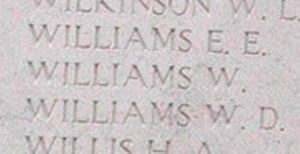
World War Two, 1939-1945
Bernard Francis Bestwick, Corporal, 4201568, Royal Armoured Corps. Bernard was born in Yorkshire on 9 October 1916, the son of Bernard Cuthbert Wint Bestwick and Ida Mary Bestwick (nee Hill). He came to Wales with his parents to work in their catering firm at Rhyl prior to the war, and married Dorothy Anne Jones, of Harbour View, Barmouth, in 1939. Bernard enlisted into the 13th/18th Royal Hussars, which was an armoured unit attached to the Royal Armoured Corps. The regiment, equipped with Sherman DD Tanks, landed at Sword Beach, Normandy on 6 June 1944 with the 27th Armoured Brigade. Bernard was killed in Normandy on 10 June 1944, aged 28. He is buried in Hermanville War Cemetery, France.
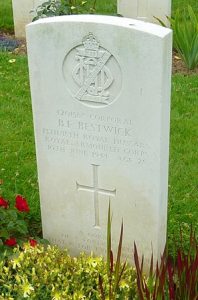
Frank Edward Clark, Warrant Officer III, 1064423, Royal Artillery. Frank was the son of George and Emma Harriet Clark. He married Kathleen Lewis, of Barmouth, in 1937. Frank was already serving with the Royal Artillery when war erupted, and was posted to France with the 27th Field Regiment, Royal Artillery, which was part of the 3rd Infantry Division of the BEF, under the command of Bernard Law Montgomery. His unit arrived at Laval, to the west of Le Mans, on 22 September 1939. Frank died there on the following day, 23 September 1939, aged 34. He is buried in Laval (Valfleury) Communal Cemetery, France. He is not commemorated on the Barmouth war memorial.
Harold Dudley, Civilian. Harold was the son of Alfred Henry Dudley and Emma Dudley, of the Barmouth Hotel. He had served with the Army Service Corps during the Great War, and married Mary Elizabeth Wellings, of Barmouth, at Brentford on 23 February 1915. The couple lived at 59, Mervan Road, Lambeth. On the night of 16 April 1941, London was hit by what was at the time the largest air raid of the war, which saw 66 boroughs hit by various bombs, High Explosive, Incendiary and parachute mines. Around 1,000 people were killed during the night. Harold and his wife Mary were in their home at 59, Mercan Road, when it was destroyed by a bomb. Harold was 62 years old, and is commemorated in Lambeth Cemetery and Crematorium. He is not commemorated on the Barmouth war memorial.
Mary Elizabeth Dudley, Civilian. Mary was the daughter of George and Annie Wellings, of Cumberland House, Barmouth. She married Harry Dudley at Brentford on 23 February 1915, and the couple lived at 59 Mervan Road, Lambeth, London. Mary was killed alongside her husband Harold during the terrible air raid on the night of 16 April 1941. She was 41 years old and is commemorated in Lambeth Cemetery and Crematorium. Mary is not commemorated on the Barmouth war memorial.
Kenneth Lloyd Ellis, Major, 88834, Royal Welch Fusiliers. Kenneth was born at Bangor on 13 May 1915, the son of William Ellis and Emily Ellis (nee Pritchard). He married Margaret Williams, of Garth, Barmouth, in 1939, when he was already a serving officer with the 6th Battalion, Royal Welch Fusiliers. The battalion was attached to 158 Brigade, 53rd (Welsh) Division, and spent much of the war on home service, first in Northern Ireland, then in southern England. By the time the Allies landed on the beaches of Normandy on 6 June 1944, Kenneth was serving as a Major with the 4th Battalion, Royal Welch Fusiliers, in the same brigade, and landed in Normandy with his battalion by 28 June 1944. The 53rd Division concentrated before relieving the 15th (Scottish) Division in the front line. The Division saw its first major action during Operation Greenline from 15 July, which was an operation designed to capture the high ground Bougy— Evrecy—Maizet, south of the Odon and some two miles South West of the small bridgehead at Baron and 158 was ordered to attack Evrecy. Kenneth was killed during the assault on Evrecy on 17 July 1944, aged 29. He is buried in Brouay War Cemetery, France.
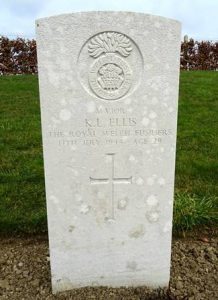
Edward Frank Field, Leading Seaman, D/J 109605, Royal Navy. Edward was born at Hungerford on24 March 1908, the son of Richard and Mary Field. He enlisted into the Royal Navy on 24 March 1926 and served aboard HMS Impregnable, HMS Ajax and HMS Royal Sovereign before being posted to HMS Vivid I. Edward married Ellen Elizabeth Edwards on 24 December 1932, and the couple lived at 2, Tainewyddion, Llanaber, Barmouth. He continued to serve with the Royal Navy, at HMS Vivid I, and saw service aboard several more ships before being demobilised and returning to his wife at Barmouth in 1938. Following the outbreak of war he re-joined the Royal Navy and was posted aboard the brand new Hunt-class destroyer, HMS Tynedale on 8 November 1940. She participated in convoy duties for most of her service and on 11 March 1941 sustained damage during an air raid on Portsmouth. She took part in the St. Nazaire Raid on 27 March 1942, escorting the destroyer Campbeltown which smashed into the Normandie Docks. She continued convoy escort duties after undergoing some repairs and in March 1943 was despatched to the Mediterranean. On 12 December 1943, Tynedale was escorting Convoy KMS34 on 12 December 1943, when she was torpedoed by the German submarine U-593 off Jijel, Algeria, and broke in two before sinking with the loss of 73 lives. Edward was 35 years old when he died that day and is commemorated on the Plymouth Naval Memorial, Devon.
Hywel Jones Griffiths, Seaman, P/X 17857A, Royal Naval Reserve. Hywel was born at Barmouth on 8 August 1913, the son of Margaret Griffith. He married Rosa Muriel Griffiths in 1939 and the couple lived at Gibraltar Terrace, Barmouth. He was a fisherman and had enlisted into the Royal Naval Reserve at Porthmadog in 1934, and served continually over the coming years, in a similar vein to the Territorial Army. On 6 October 1939 he was called up for service with the Royal Navy and posted to HMS Victory I at Portsmouth and was posted aboard the armed merchant cruiser, HMS Patroclus. On 3 November 1940 the German submarine U-99 torpedoed the SS Casanare, which sent out an SOS call. The armed merchant cruisers HMS Laurentic and HMS Patroclus arrived quickly, but Laurentic was soon torpedoed by the U-99. Patroclus, instead of attempting to sink the U-Boat, began picking up survivors, and was herself torpedoed and foundered with the loss of 56 lives. Hywel was 27 years old when he died in the sinking and is commemorated on the Portsmouth Naval Memorial, Hampshire.
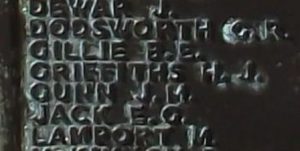
Richard Hughes, Royal Air Force Volunteer Reserve. Richard cannot presently be identified. The memorial states that he lived at Drill y Gar.
Evan Jones, Gunner, 1543726, Royal Artillery. Evan was the son of Ann Jones, of Barmouth, and the husband of Mary Jones, of Midland Flats, Barmouth. Very little is known of him, but he served with the Royal Artillery. Evan died on 5 January 1940, aged 47, and is buried in St. Mary’s Churchyard, Llanaber.
Richard Emrys Jones, Sergeant, 626828, Royal Air Force. Richard was born at Maypole House, Barmouth in 1921, the son of Richard Isaac Jones and Violet Jones. He married Edith Jones after having enlisted into the Royal Air Force. He trained as a Navigator prior to being posted to 9 Squadron, RAF, which was a heavy bomber unit, stationed at RAF Bardney. On the night of 2 December 1943, Richard took off from Bardney aboard Lancaster I, Serial DV334, for a raid on Germany. The Lancaster suffered problems while landing early on the following morning, 3 December 1943, and crashed near the village of Milton whilst on the approach to RAF Gamston, killed all of her crew of six. Richard was 22 years old when he died that morning and is buried in Wallasey (Rake Lane) Cemetery, Liverpool.
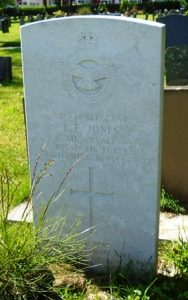
Cyril Keith Lanman, Ordinary Seaman, Merchant Navy. Keith was born at Aberdare in 1923, the son of Cyril Arnold Lanman and Florence Lanman (nee Linney). By 1939 the family had moved to Lawrenny Lodge, Barmouth. Cyril enlisted into the Merchant Navy and was posted aboard the Liverpool registered Elders & Fyffes steamship SS Aracataca. On 16 November 1940 Aracataca left Port Antonio, Jamaica, carrying a cargo of some 1,600 tons of bananas and grapefruit, and reached Halifax, Nova Scotia before setting off across the Atlantic for Avonmouth. During the early hours of 30 November 1940 Aracataca was struck by a torpedo which had been fired by the German submarine U-101, some 230 miles west of Rockall. The ship came to a stop and began to list quickly in the heavy seas, but managed to lower all four of her lifeboats. The Germans were going to surface to use their deck-gun against the survivors, but the rough seas prevented this, so they fired another torpedo at the stricken ship, which exploded and sank. Cyril was among 36 men who lost their lives as a result of the sinking that day, while 33 men were rescued. Cyril was 17 years old and is commemorated on the Tower Hill Memorial, London alongside his fellow crewmen.
Arthur Llewellyn Lewis, Officer Cadet, 15000293, North Staffordshire Regiment. Arthur was the son of Thomas Lewis and Mary Anne Lewis (nee Jones), of Llwyn Selyn, Barmouth. He enlisted into the North Staffordshire Regiment, and was posted to India. Arthur gained a commission into the regiment, and became an officer cadet. Arthur died in India on 1 July 1942, aged 27. He is buried in Delhi War Cemetery, India.
Idris Lewis, Leading Aircraftman, 616394, Royal Air Force. Idris was born at Treorchy in 1906, the son of John and Fanny Lewis. His father was from Barmouth, and after WW1 moved the family back to his native home. Idris married Hetty Jenkins, of Beach House, Barmouth, in 1929. Idris enlisted into the Royal Air Force and was posted to 205 Squadron, RAF, which was based in Singapore. The Squadron flew patrols over the approaches to Singapore, based mainly in Singapore, but also from satellite bases in Ceylon and the Nicobar. It was re-equipped with PBY Catalinas in 1941 before being withdrawn from Singapore and relocated to Java. On 5 April 1942, Idris was flying aboard Catalina Z2144 on a patrol south of Ceylon, when it was attacked by Japanese aircraft and shot down into the Indian Ocean, with the loss of all its crew of eight men. Idris was 35 years old when he died that day, and is commemorated on the Singapore Memorial, Kranji. Just three weeks later, Java was invaded by the Japanese, and the survivors of 205 Squadron retired to the south of the island before being evacuated to Australia.
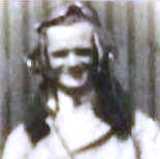
Edward Einion Morris, Guardsman, 2735111, Welsh Guards. Edward was the son of Owen and Mary Williams Morris, of Glan-Glasfor, Barmouth. He worked as a Gents Outfitter in Stockport prior to enlisting into the army and was posted to the 3rd Battalion, Welsh Guards, which was an armoured unit. The battalion sailed for North Africa on 5 February 1943, landing at Algiers, and joined the 1st Guards Brigade at Medjez el Bab. The battalion saw heavy fighting in North Africa and had reached Hammam Lif when the Germans surrendered. Ealy in 1944 the battalion moved to Italy, and took part in the arduous campaign, seeing action at Monte Cerasola, before pushing north to Monte Piccolo. Edward was killed during a costly action at Acre on 29 May 1944. He was 32 years old and is buried in Cassino War Cemetery, Italy.
Orthin Vaughan Owen, Sergeant, 994134, Royal Air Force Volunteer Reserve. Orthin was the son of the Reverend Richard Vaughan Owen, B.A., and Maggie Elizabeth Owen, of Port Dinorwic. He lived at Epworth Villa, Barmouth prior to enlisting into the Royal Air Force Volunteer Reserve, and was posted to 57 Squadron, RAF. The Squadron had been in France at the outbreak of war, and after being evacuated from France moved to RAF Wyton. It then moved to RAF Elgin to carry out anti-shipping patrols against the Norwegian coast. The squadron moved to RAF Feltwell in November 1940 to re-equip with the Vickers Wellington. On the night of 11 August 1942 Orthin took off from Feltwell aboard Wellington Z1656 for a raid on Mainz. The aircraft came down in the sea on its return journey on 12 August 1942, with the loss of all its crew of five men. Orthin’s body was the only one recovered from the crash, being recovered from the sea, and he was buried in Ameland (Nes) General Cemetery, Netherlands.
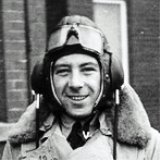
Owen Parry, Stoker 1st Class, D/KX 138899, Royal Navy. Owen was born on 30 January 1922, the son of Owen Parry and Mabel Parry (nee Geddes), of Rose Hill, Barmouth. He enlisted into the Royal Navy and was posted aboard the minelayer HMS Abdiel. She was on trials in March 1941 when she was put into service and laid mines off the port of Brest to attempt to prevent the breakout of the German battleships Scharnhorst and Gneisenau. She then continued her sea trials before joining the Mediterranean Fleet and began operations in the Mediterranean. She helped land a force of Commandos at Suda Bay, Crete in May 1941, before helping with the evacuation of the Island following its fall. Abdiel continued her work in minelaying around the Italian shipping routes, and gained a number of successes when several Italian warships were sunk by her mines. On 10 September 1943, Abdiel was carrying troops of the 1st Airborne Division into Taranto Harbour when she struck mines which had been laid by German MTB’s earlier that morning, and sank with the loss of 106 lives. Owen was 21 years old when he was killed that day and is commemorated on the Plymouth Naval Memorial, Devon.
David Prewer, Sergeant, 1681110, Royal Air Force Volunteer Reserve. David was the son of Fred John Prewer and Elizabeth Lewis Prewer (nee Parry) of Glan y Mawddach, Barmouth. He enlisted into the Royal Air Force Volunteer Reserve, and was posted to 44 (Rhodesia) Squadron, RAF. The squadron was part of No. 5 Group at the outbreak of war, based at RAF Waddington, with Handley Page Hampdens. In 1941 it became the first squadron to convert completely to Avro Lancasters, and moved to RAF Dunholme Lodge. On the night of 20 April 1944, David took off from RAF Dunholme Lodge aboard Lancaster III, Serial ND573, as part of a large force despatched to bomb the railway yards at La Chappelle. The Lancaster was lost without a trace on the following morning, 21 April 1944, with all her crew. David was 30 years old when he was killed that day and is commemorated on the Runnymede Memorial, Surrey.
Francis Arthur Price, Warrant Officer, 34663, South African Corps of Signals. Francis was the son of James and Martha Price, of Enfield House, Barmouth. He had emigrated to South Africa as a young man, and served with the South African Forces. By the time war broke out he was serving with the South African Corps of Signals, and was posted with his unit to North Africa to take part in the campaign against Mussolini’s Italian forces, which had invaded Egypt in September 1940. Francis died in North Africa, possibly at Tobruk, on 8 December 1941, aged 49. He has no known grave and is commemorated on the Alamein Memorial, Egypt. He was Mentioned in Despatches in December 1941, just after his death.
Edward Albert William Read, Corporal, 1064311, Royal Army Service Corps. Edward was the son of William and Eva Read. He married Phyllis Hartley, of 2, Bloemfontein Terrace, Barmouth, on 29 November 1934, and the couple set up home at 2, Park Road, Barmouth. Edward enlisted into the army following the outbreak of war and was posted to the 313th General Transport Company, Royal Army Service Corps. Edward served in Italy with his unit, and died there on 13 September 1943, aged 36. He is buried in Catania War Cemetery, Sicily.
Humphrey Ronald Roberts, Leading Aircraftman, 1148220, Royal Air Force Volunteer Reserve. Humphrey was born on 23 March 1922, the son of Richard and Rose Mary Roberts, of Frondewi, Barmouth. He enlisted into the Royal Air Force Volunteer Reserve, and was posted to 456 (RAAF) Squadron, RAF. The Squadron was a Royal Australian Air Force night-fighter squadron, which formed at RAF Valley on 30 June 1941, equipped with the Defiant fighter, but re-equipped with Bristol Beaufighters. It carried out defensive operations all over Britain, before re-equipping with the De Havilland Mosquito. On 23 May 1943, Humphrey on a training flight aboard a Miles Magister P2464, from RAF Sealand, when it crashed near Salisbury, killing Humphrey and his pilot, Roger Hitchcock. Humphrey was 21 years old when he was killed that day and his remains were brought home for burial in St. Enddwyn’s Churchyard, Llanenddwyn.
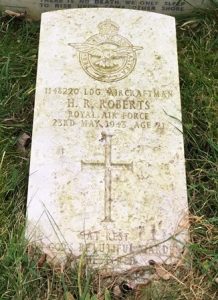
Henry John Rowberry, Lance Bombardier, 1155047, Royal Artillery. Henry was born at Merthyr on 3 October 1914, the son of John and Alice Rowberry. He enlisted into the Royal Artillery soon after the outbreak of war, and was based near Barmouth when he married Glenys Steadman, of Barmouth, in 1943. Henry was then posted to East Africa with his unit. Henry died in Africa on 12 February 1944, aged 29. He has no known grave and is commemorated on the East Africa Memorial, Nairobi. Henry is not commemorated on the Barmouth memorial.
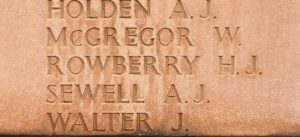
Rowland Rowlands, Able Seaman, D/233615, Royal Navy. Rowland was born on 8 July 1889, the son of Rowland and Elizabeth Rowlands, of Goronwy Terrace, Barmouth. He enlisted into the Royal Navy on 8 July 1907 and served throughout the Great War, taking part in the Battle of Jutland aboard HMS Bellerophon on 31 May 1916. He was wounded during the Zeebrugge Raid on 23 April 1918 whilst serving aboard HMS Hindustan. In 1919 he joined the Royal Fleet Reserve at Devonport, then re-joined the Royal Navy on 27 August 1920, continuing his service throughout the inter-war years. On 23 September 1939 Rowland was posted aboard the newly converted Armed Merchant Cruiser HMS Rawalpindi. On 23 November 1939 Rawalpindi was patrolling north of the Faroe Islands when she encountered the German battleships Scharnhorst and Gneisenau. Rawalpindi managed to radio the sighting back to the Admiralty, before launching a suicidal attack against the two ships, and was sunk within 40 minutes with the loss of 238 lives. Rowland was 50 years old when he died that day, and is commemorated on the Plymouth Naval Memorial, Devon.
Bryan Thomas, Sergeant, 1051799, Royal Air Force Volunteer Reserve. Bryan was born at Aberystwyth on 14 February 1912, the son of Edward Campbell Thomas and Sarah Jane Thomas (nee Jones). Prior to 1939 the family had moved to 1, Cumberland Place, Barmouth. Bryan served as a Wireless Operator/ Air Gunner with 142 Squadron, Royal Air Force. In 1941 the squadron was flying the Vickers Wellington, on strategic night bombing missions. At around 18.30 on 21 October 1941 Bryan took off from RAF Binbrook aboard Wellington IV, Serial Z1210, which was part of a force despatched to bomb Bremen. The aircraft failed to return from the raid the following morning and was presumed to have crashed into the North Sea. Bryan was 29 years old when he was killed on 21 October 1941. He is buried in Sage War Cemetery, Germany. The cemetery in made up of many airmen, most of whom were lost in bombing raids over northern Europe, who were brought in from other cemeteries after the war were for reburial.
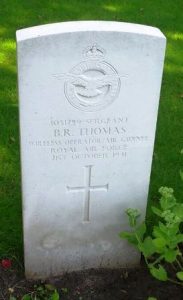
Edward Eryl Hughes-Williams, Lieutenant, Royal Naval Volunteer Reserve. Edward was born at Bangor on 19 April 1905, the son of Richard and Ethel Hughes-Williams. He married Theresa Frayling in 1929. Edward had served with the Royal Air Force for several years after enlisting on 4 February 1922, before becoming a successful businessman, with homes at Solihull and at Barmouth, and had learned to fly, gaining his pilots license at the Midland Aero Club on 11 June 1937. By now his parents had moved to The Rectory, Barmouth, where his father was Vicar. Edward enlisted into the Fleet Air Arm following the outbreak of war and was posted aboard the aircraft carrier HMS Victorious. Two weeks after completing her commissioning in 1941, Victorious took part in the hunt for the German battleship Bismarck. Later that year she was detached to Gibraltar, and with Ark Royal and a naval escort, conveyed a large number of Hawker Hurricane aircraft to reinforce the besieged British base at Malta. In late July 1941, she escorted HMS Adventure to Murmansk with a load of mines and on 31 July 1941 she took part in the raid to attack enemy shipping at Kirkenes and Petsamo, but thirteen of her aircraft were lost when they came under attack by German fighters. Edward was killed in action during the raid that day. He was 36 years old and is commemorated on the Lee-on-Solent Memorial, Hampshire.
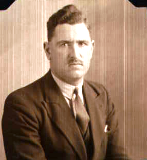

Charles Arthur White, Corporal, 4195550, Royal Welch Fusiliers. Charles was born in Birmingham on 6 September 1898, the son of George and Rosanna White. He had moved to Barmouth after the Great War and married Margaret Ellen Gavin in 1927. Charles served with the Royal Welch Fusiliers during the Second World War. Nothing further is known of his service, but he died at Barmouth on 21 January 1946, aged 47, and is buried in Barmouth and Llanaber Joint Burial Ground. He is not commemorated on the Barmouth war memorial.
